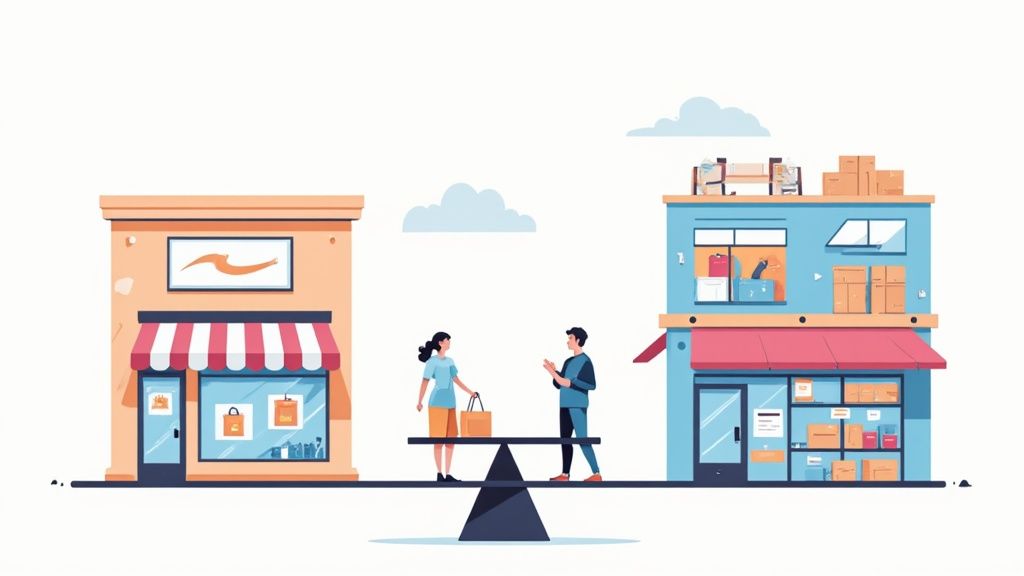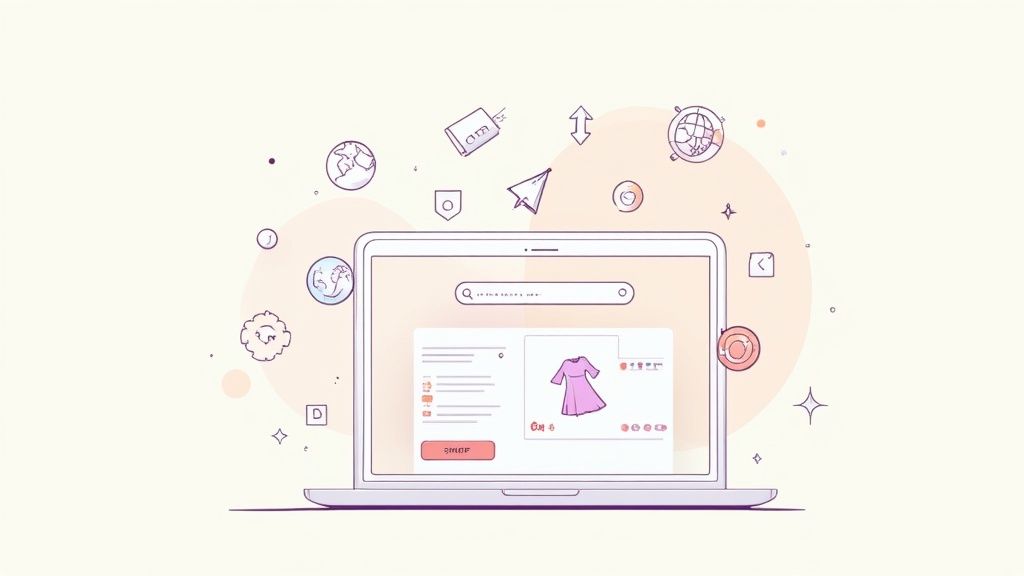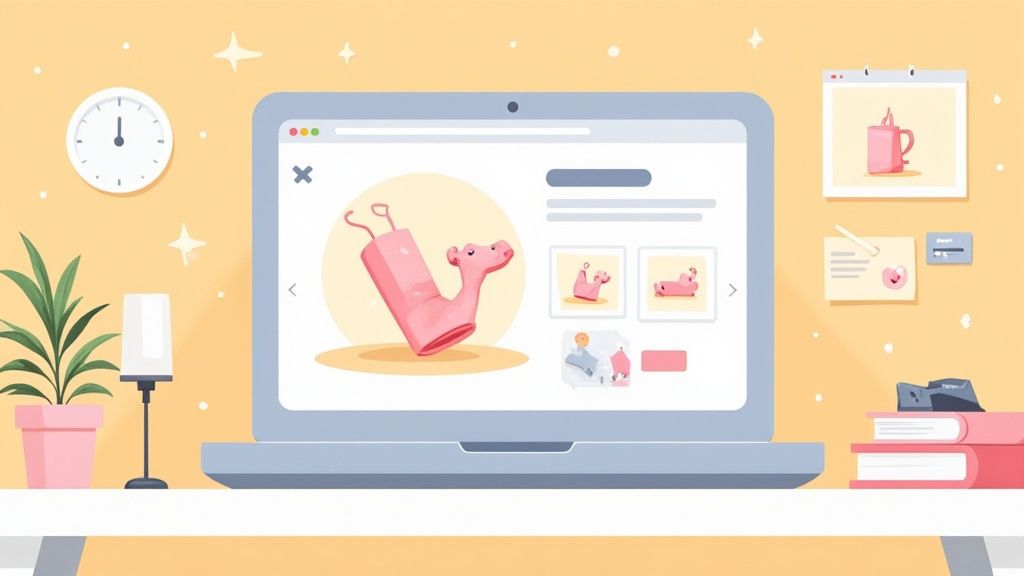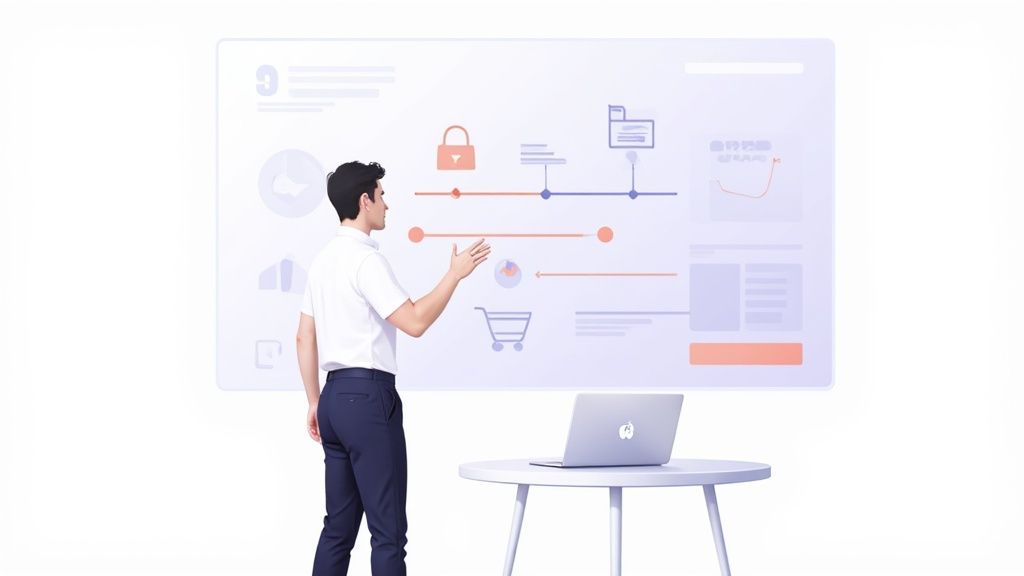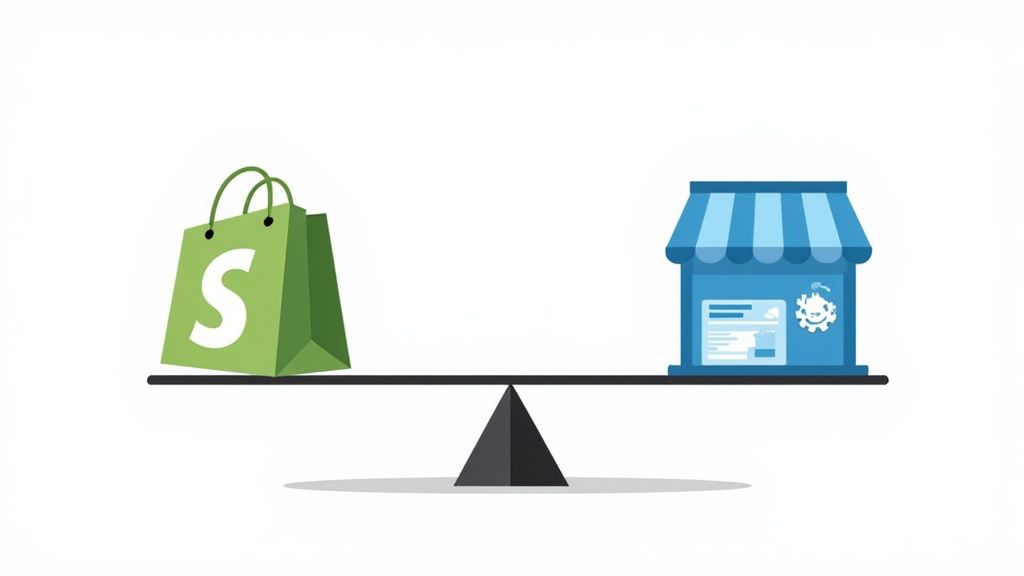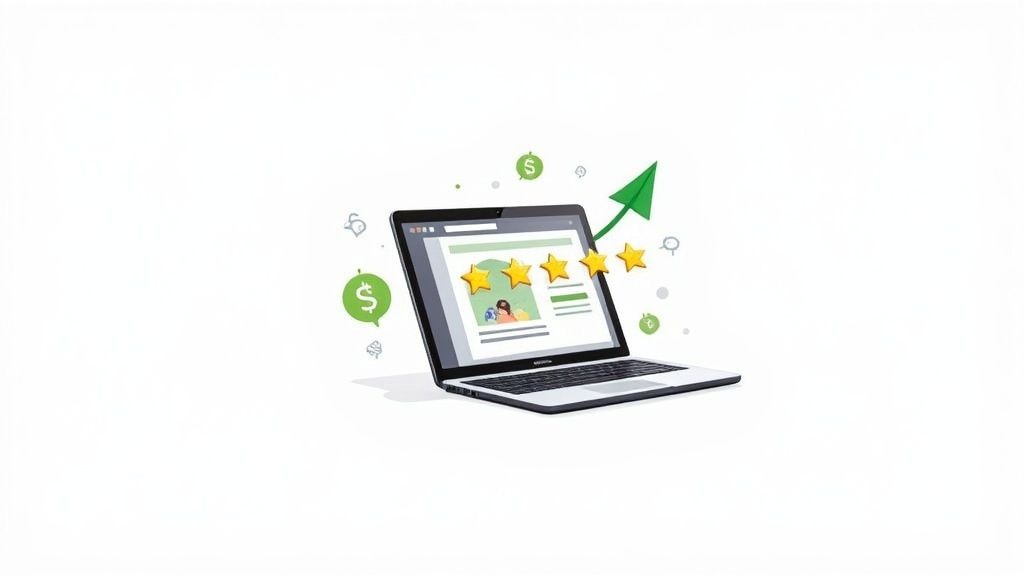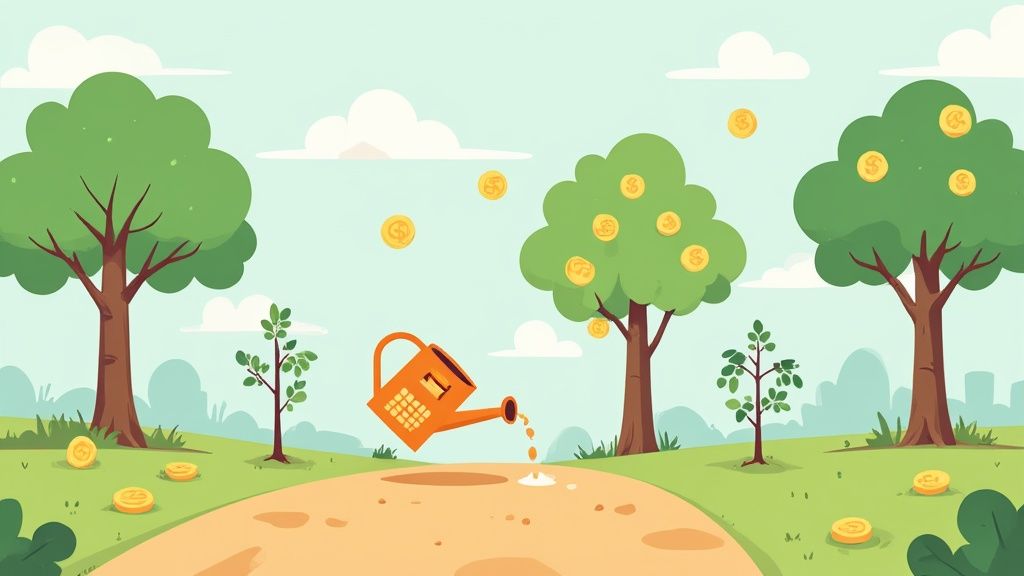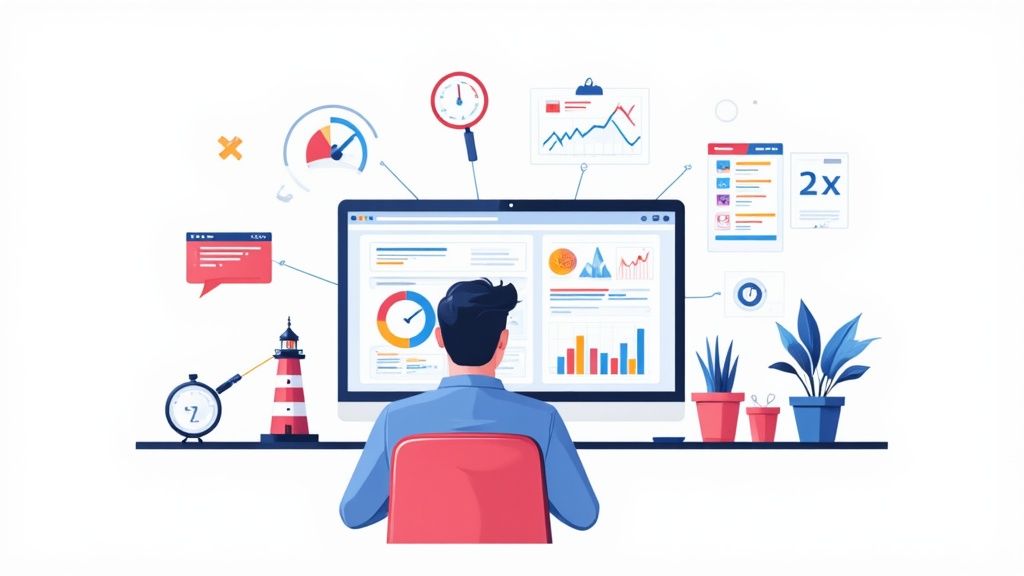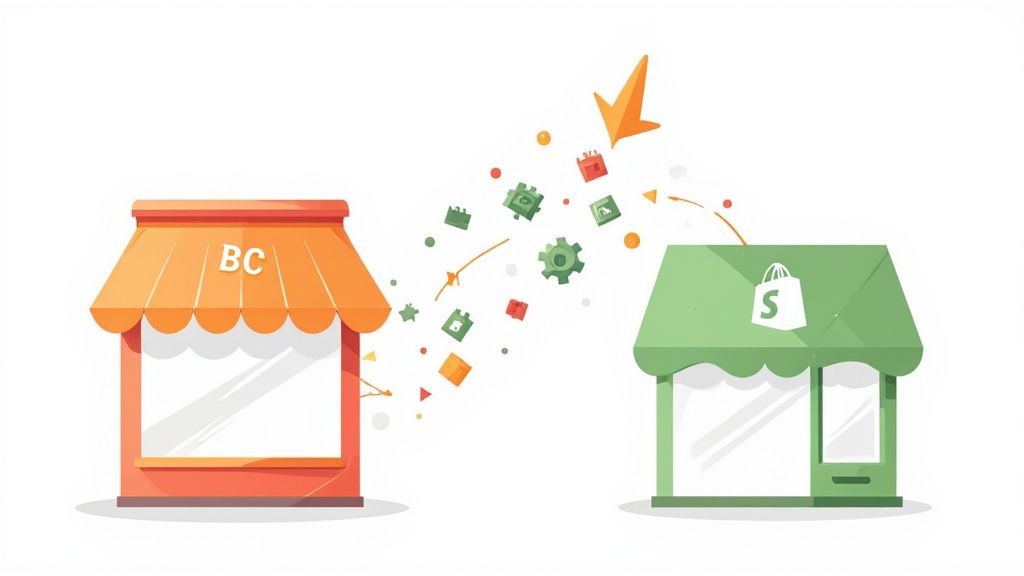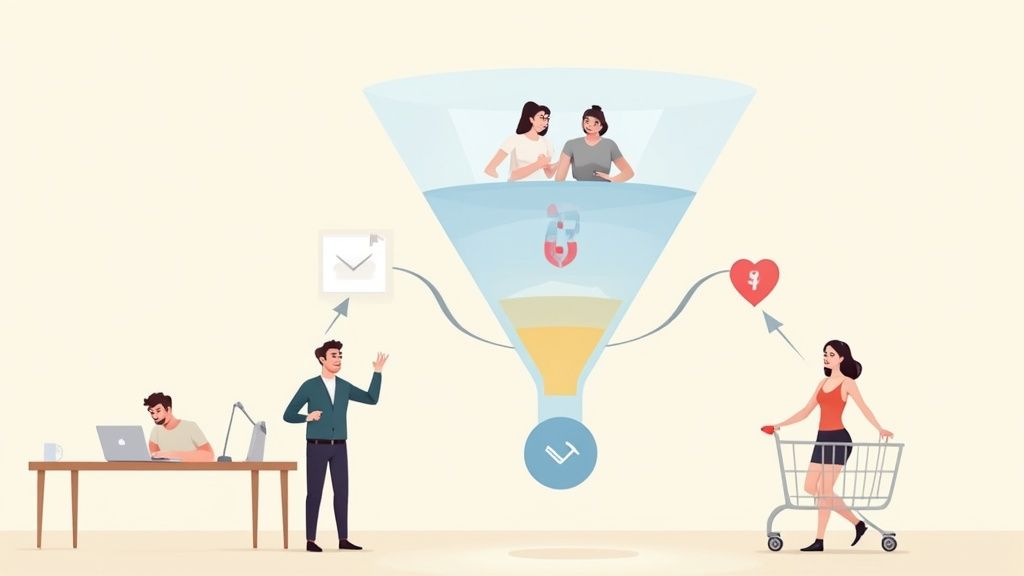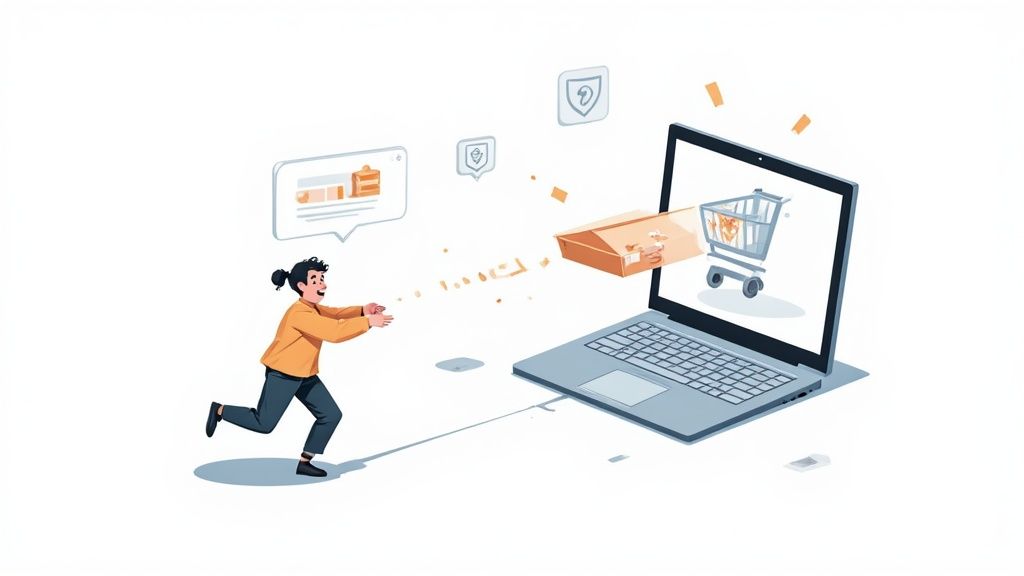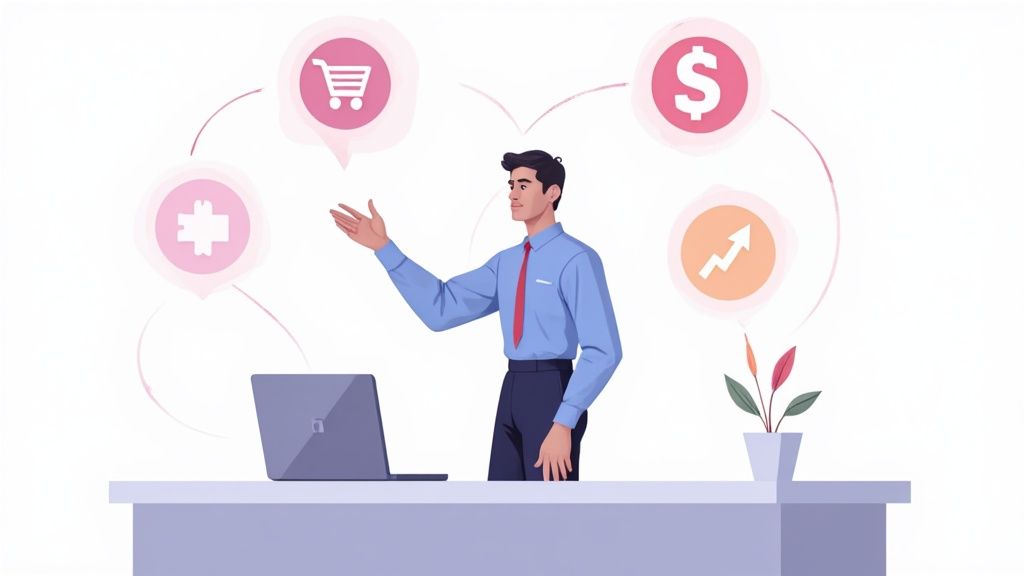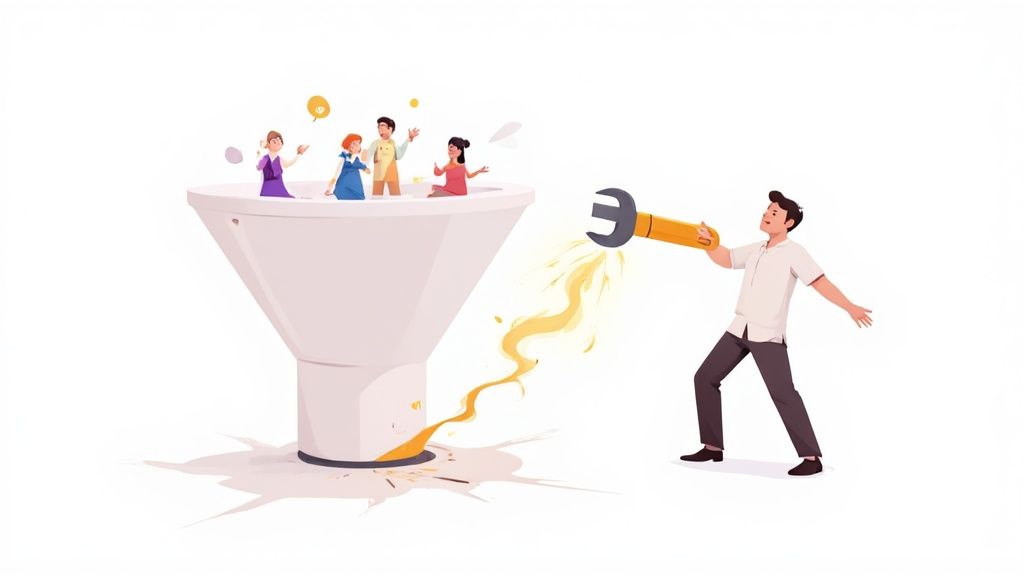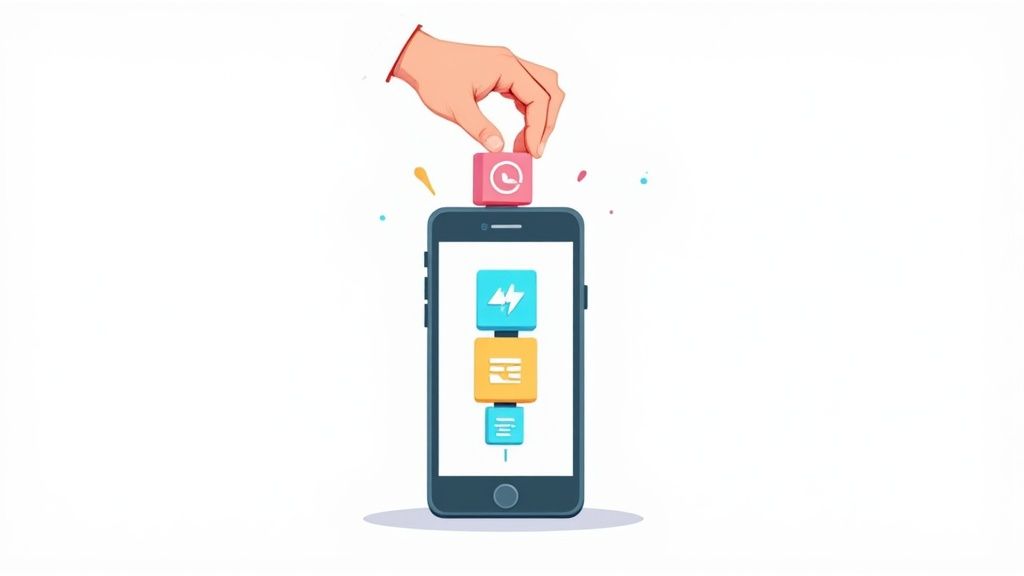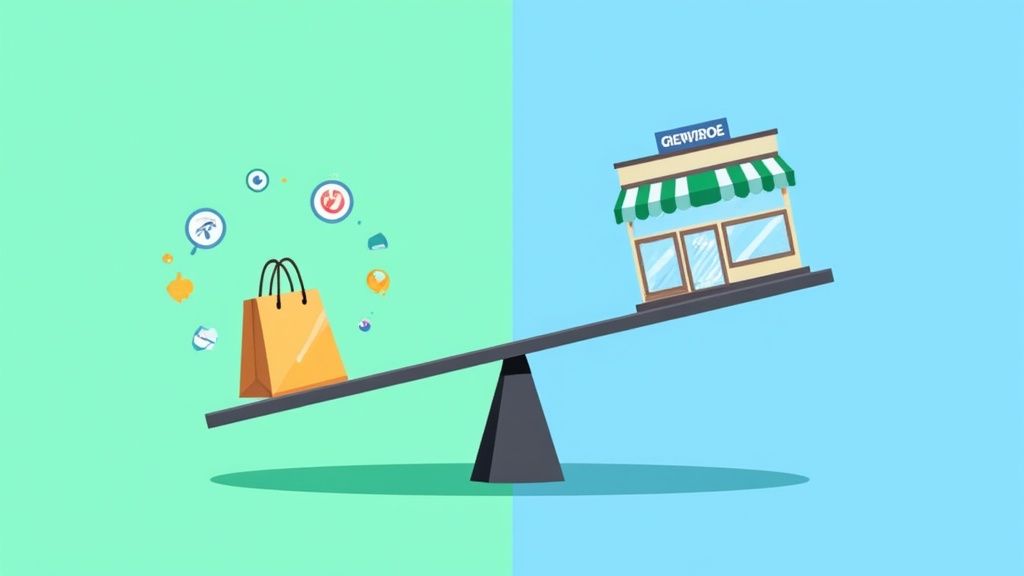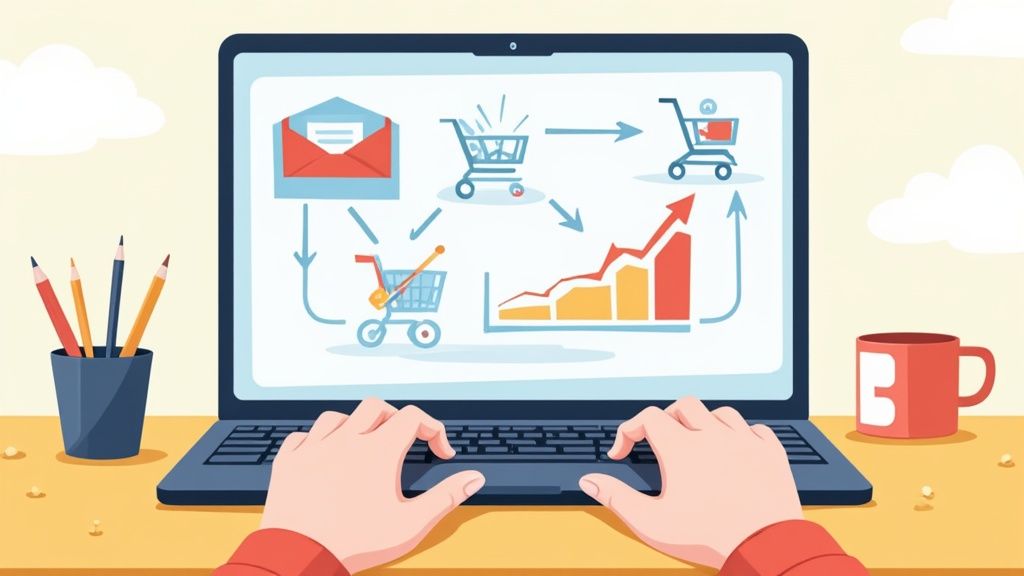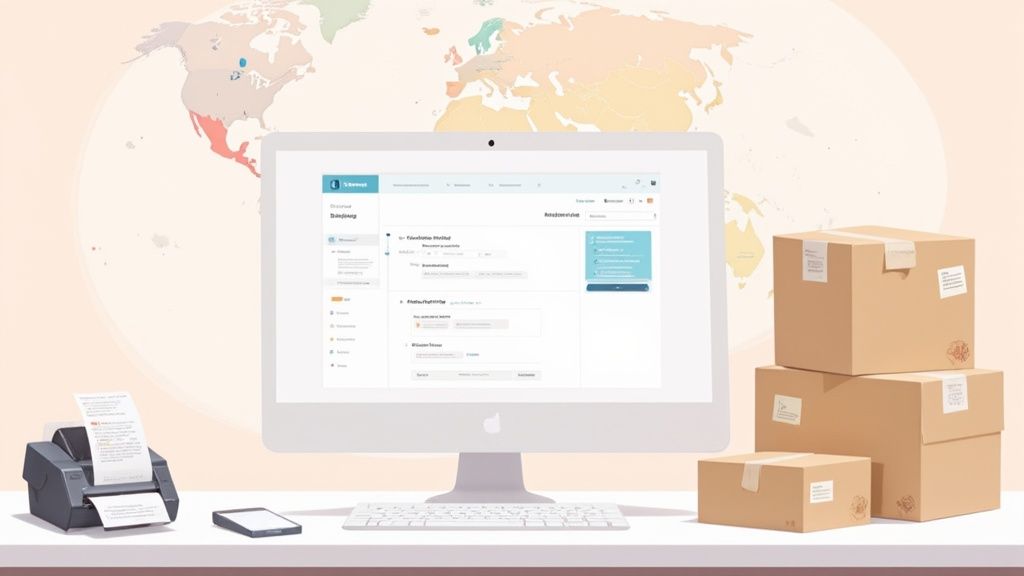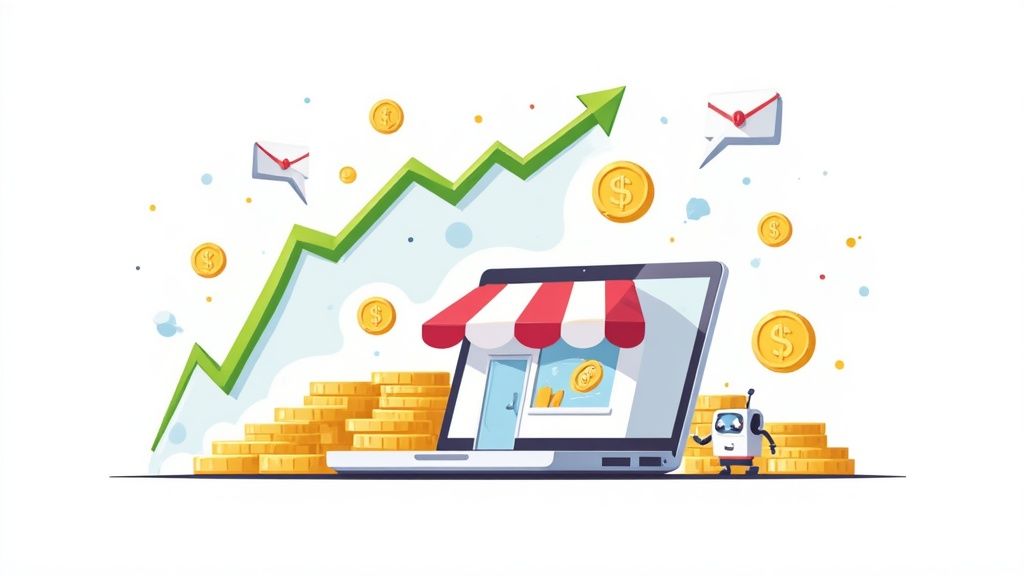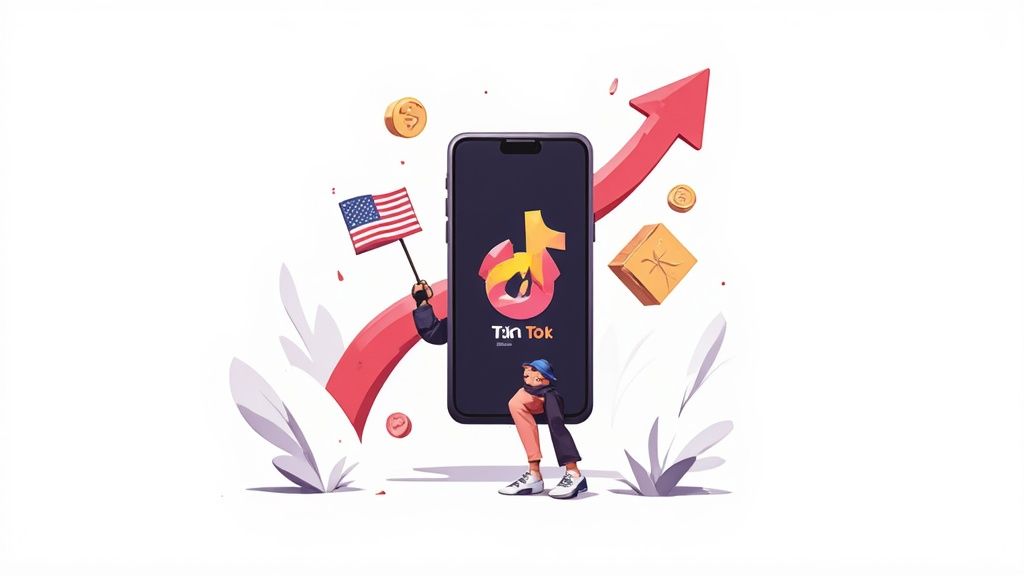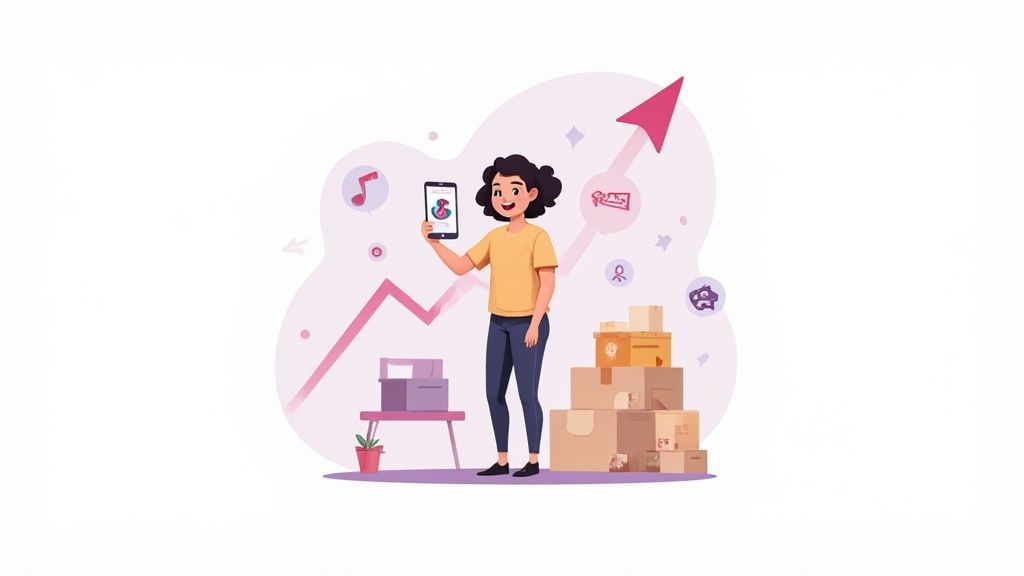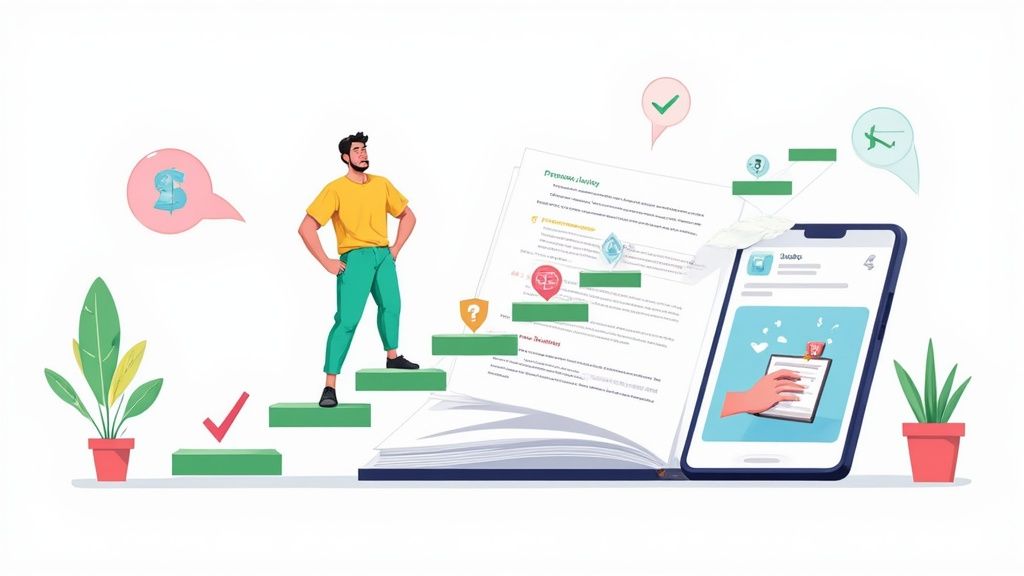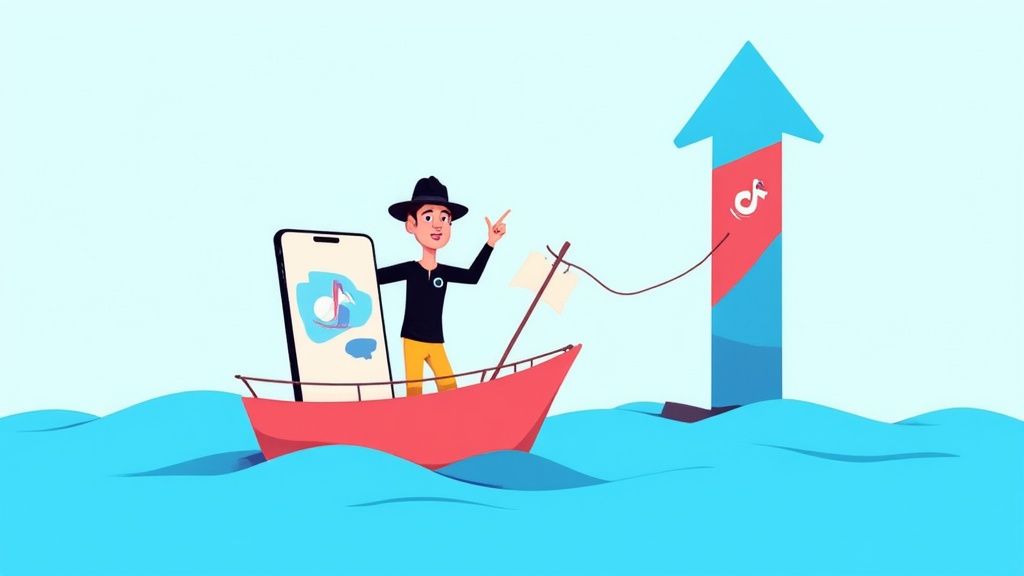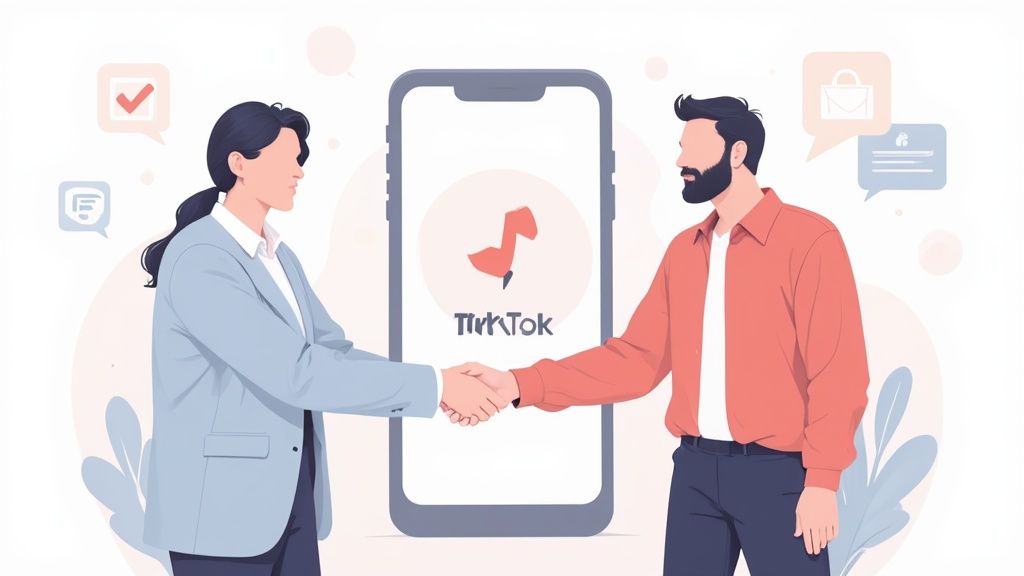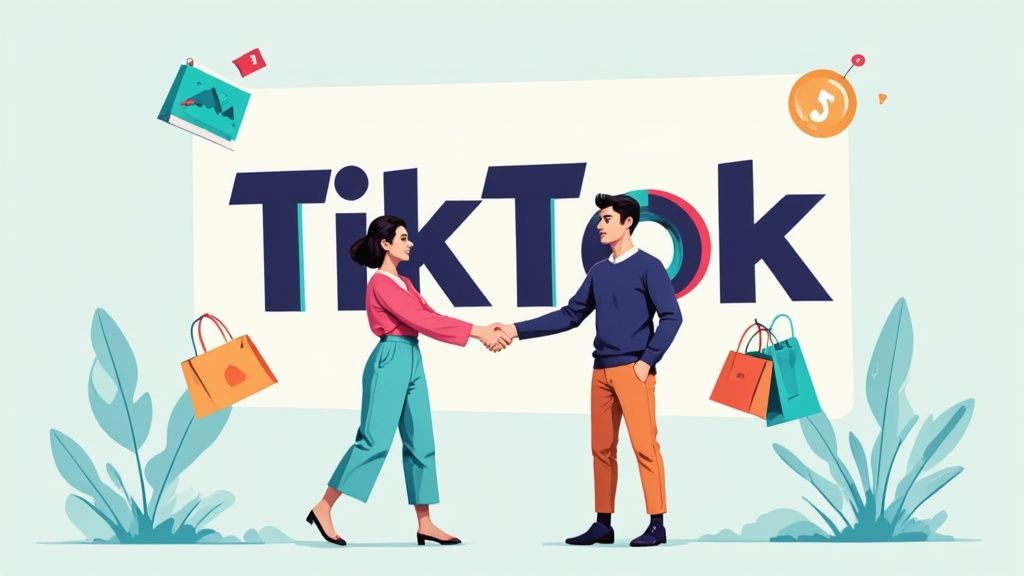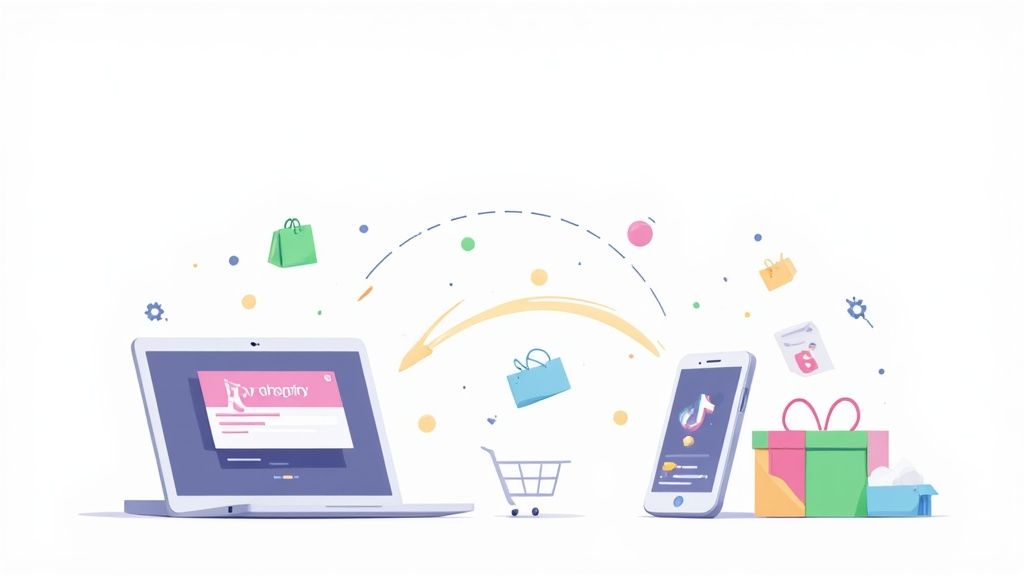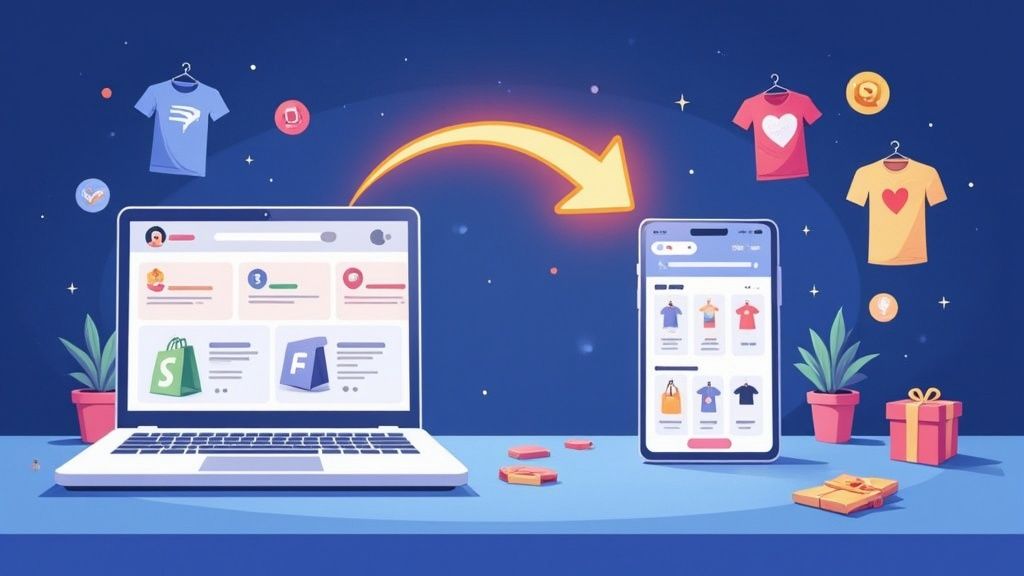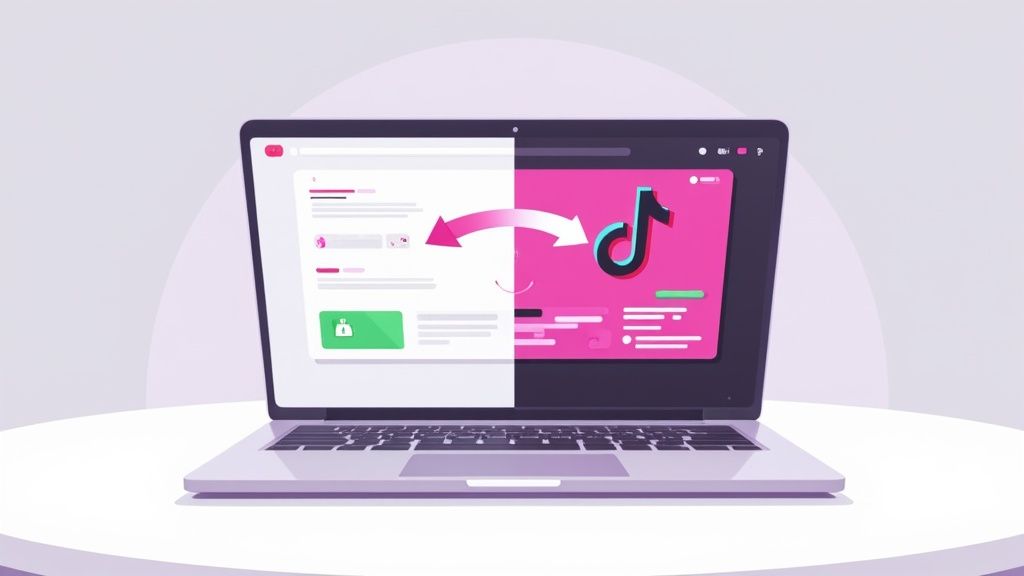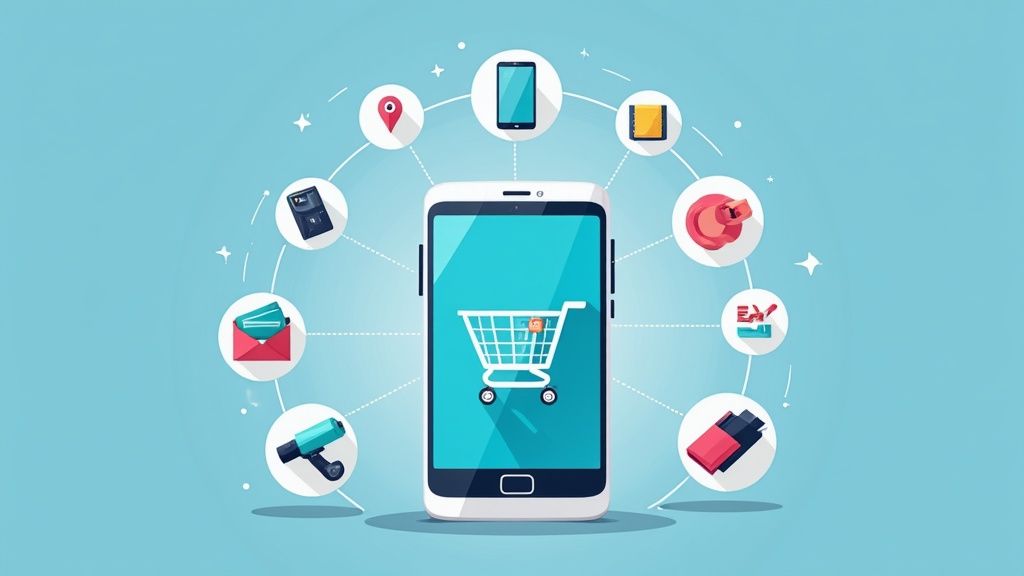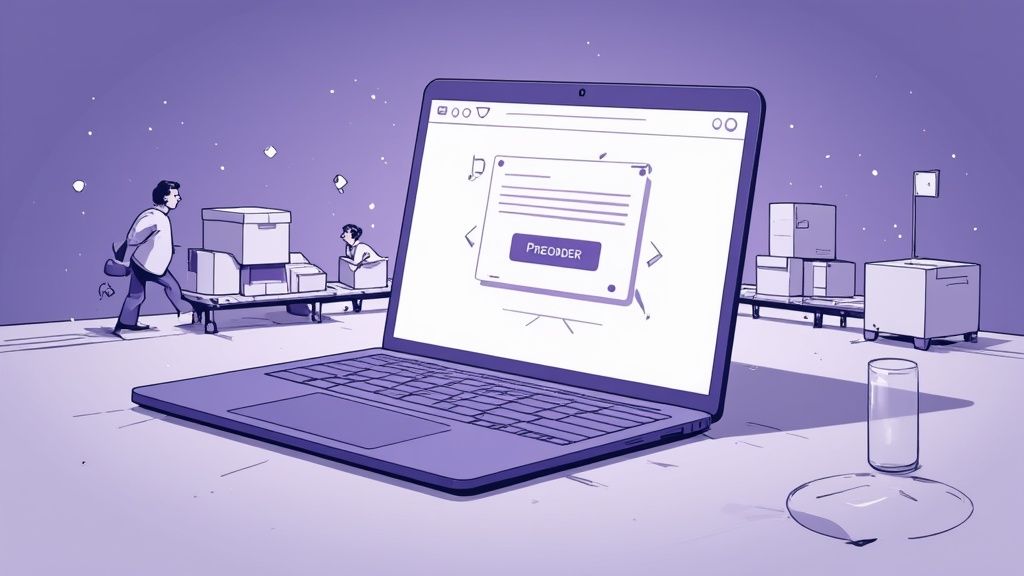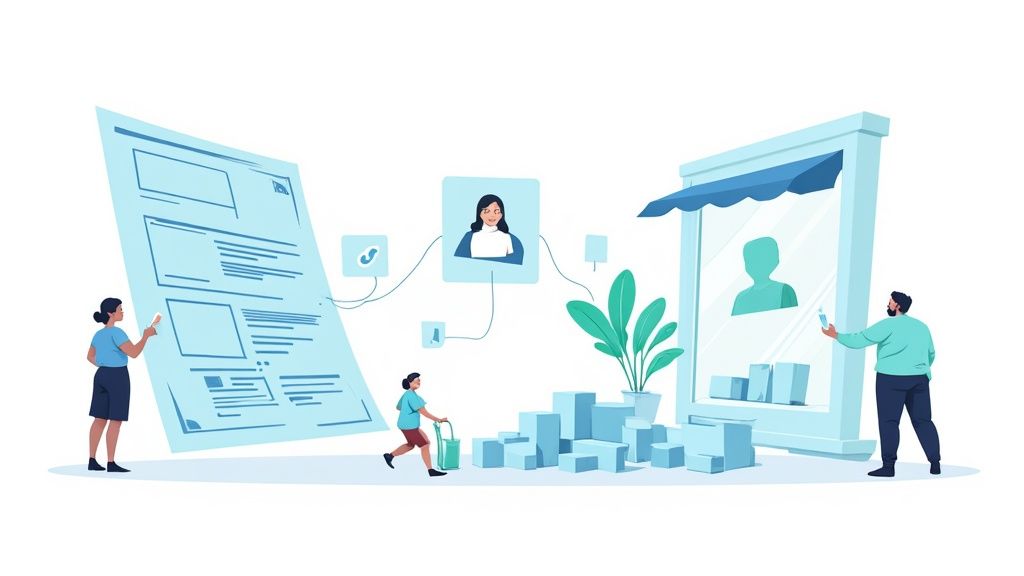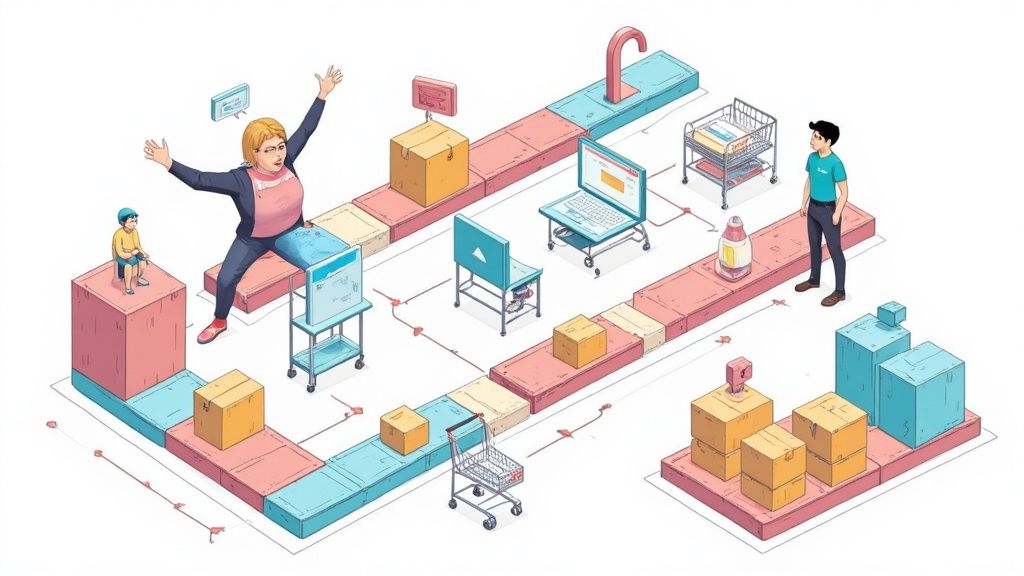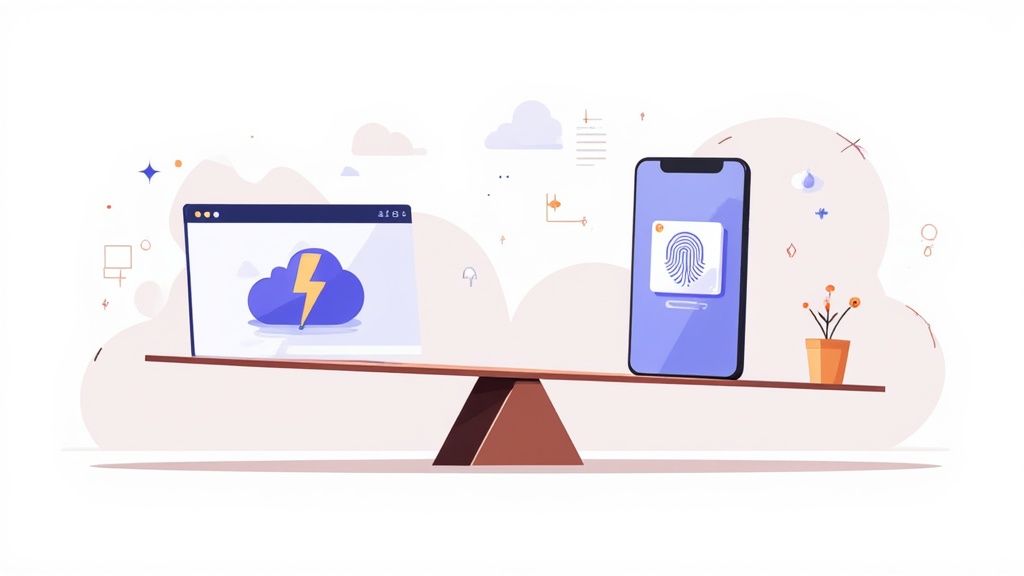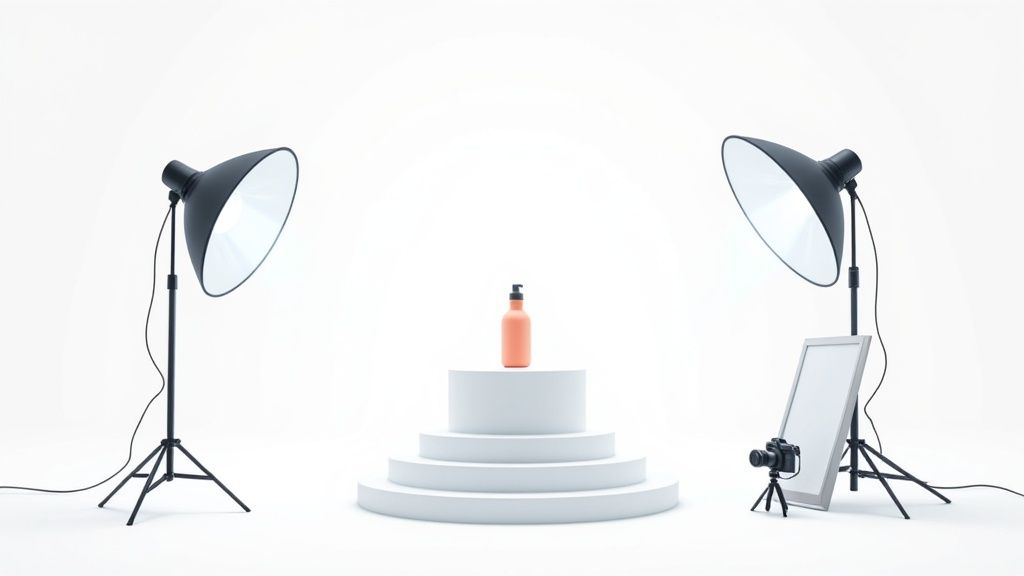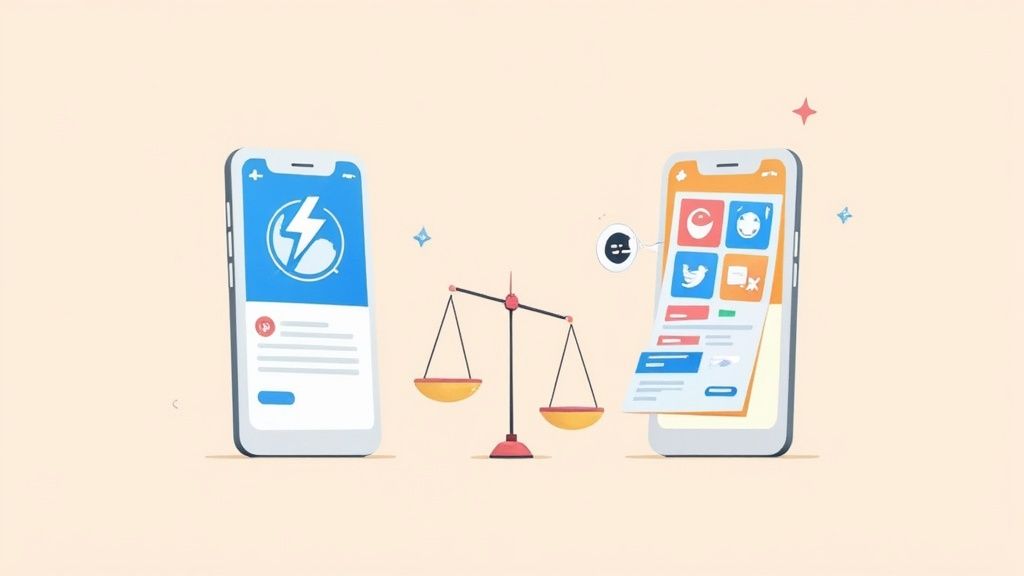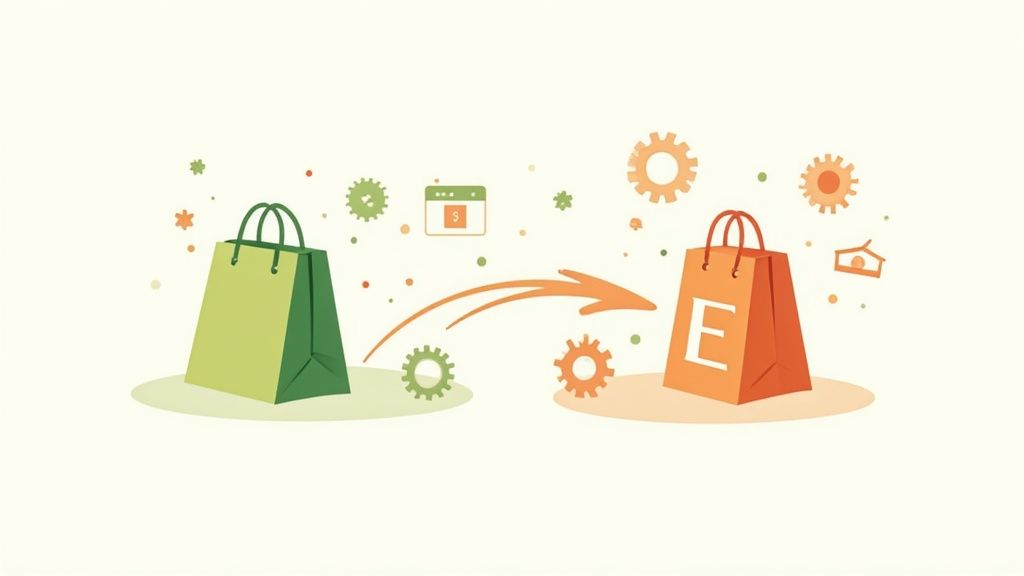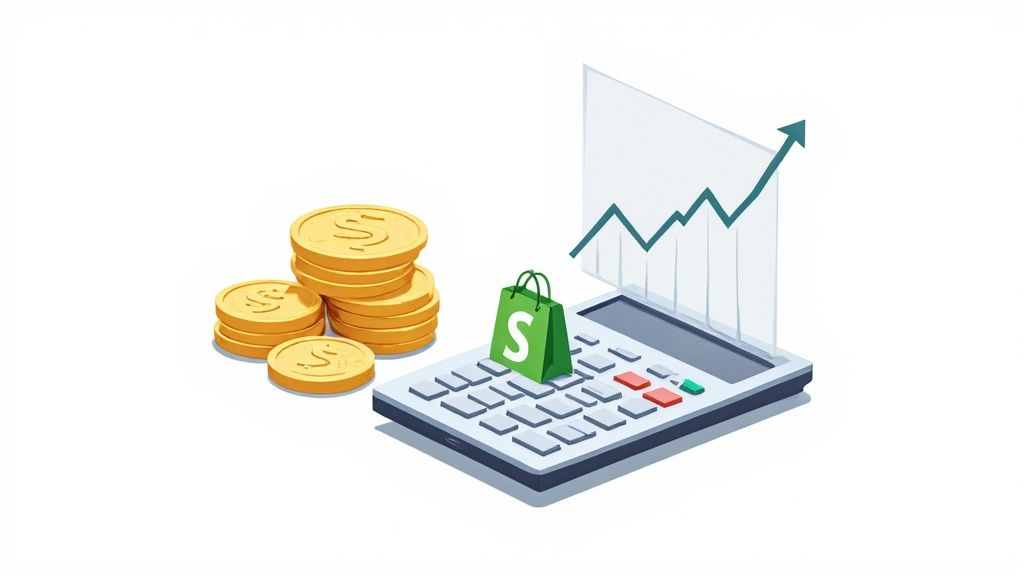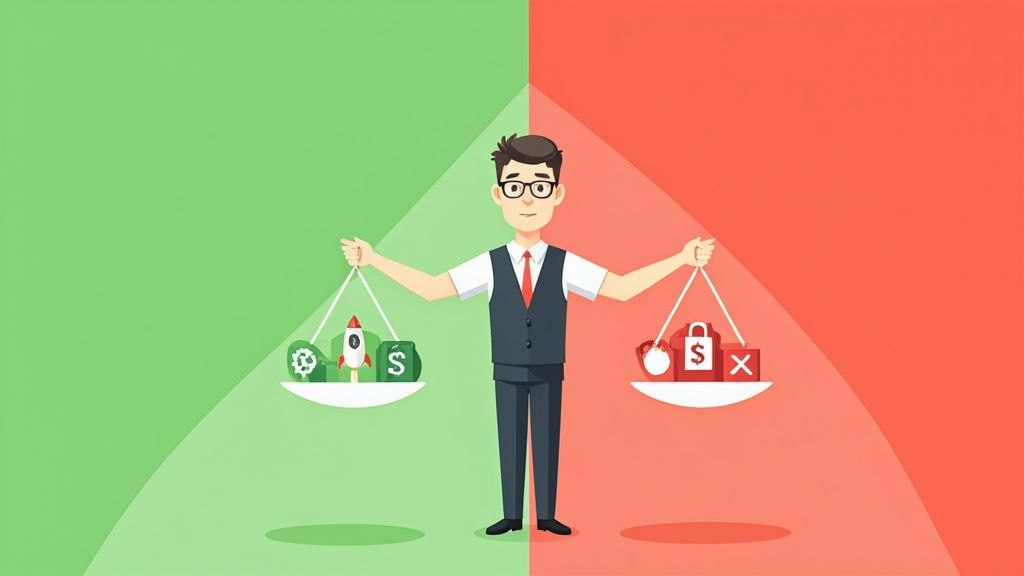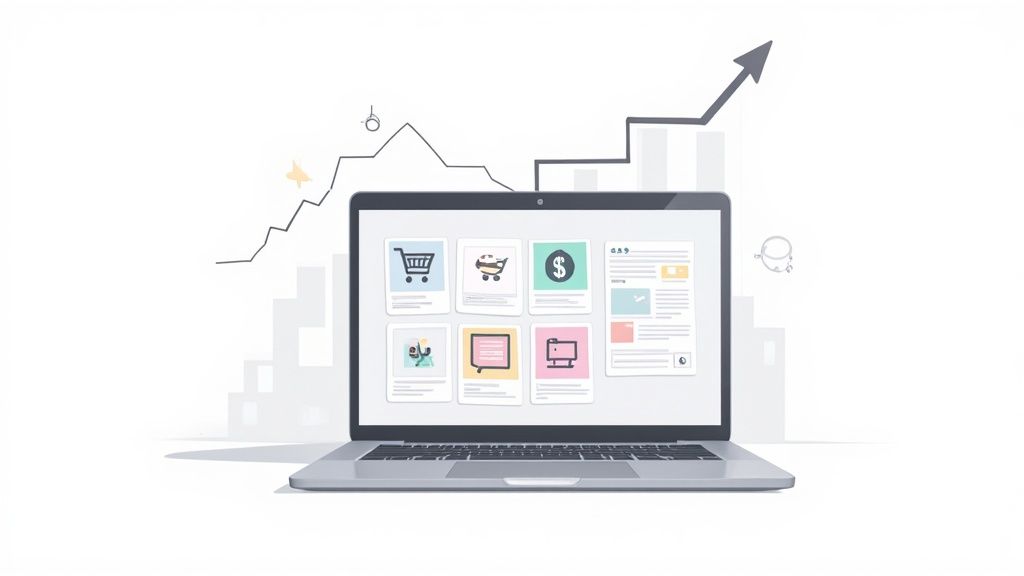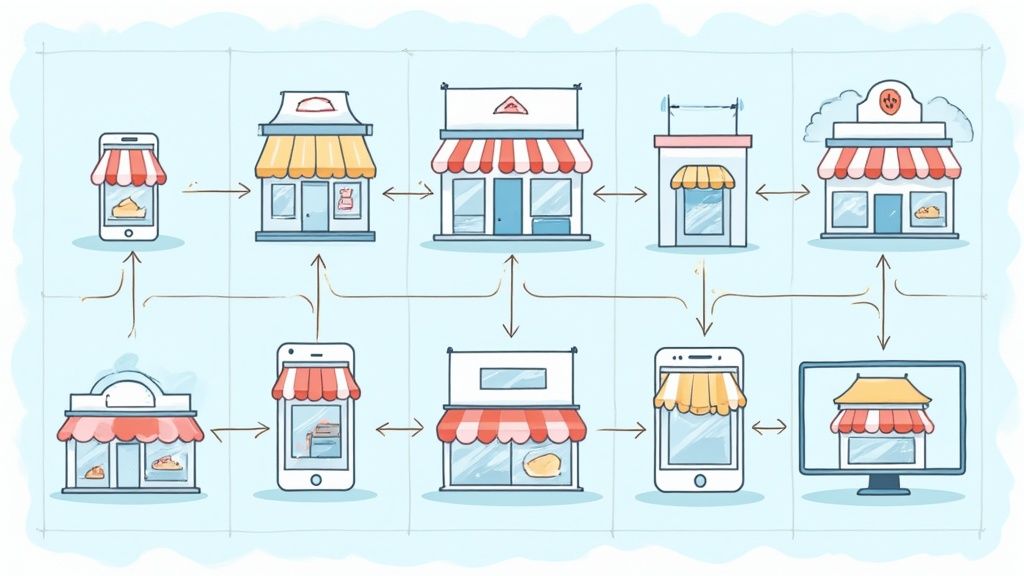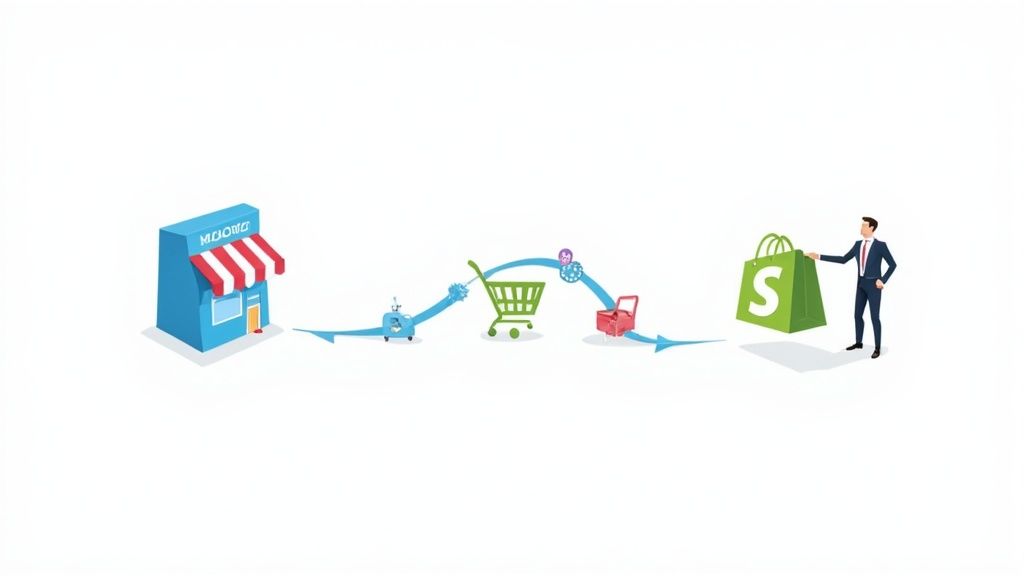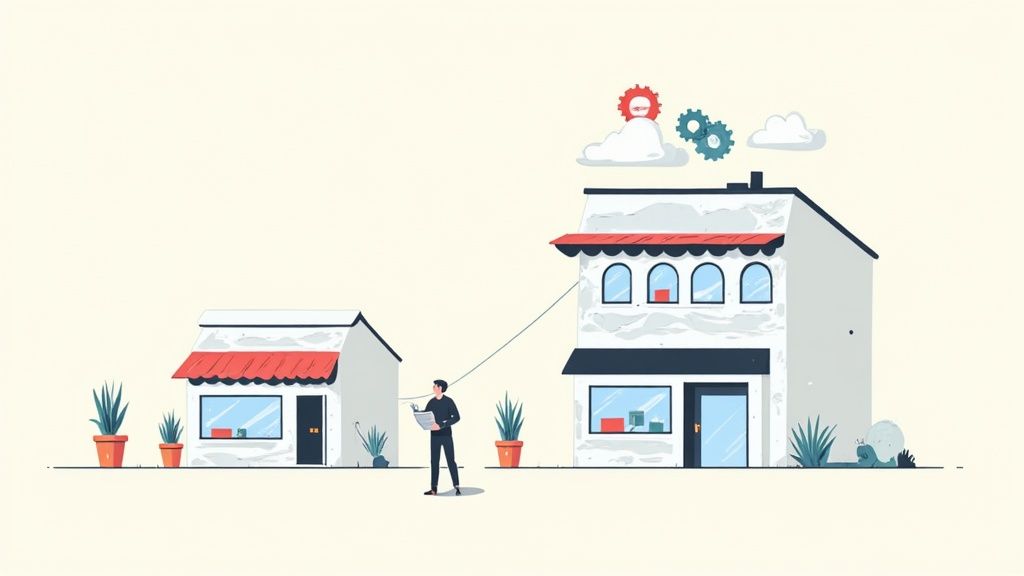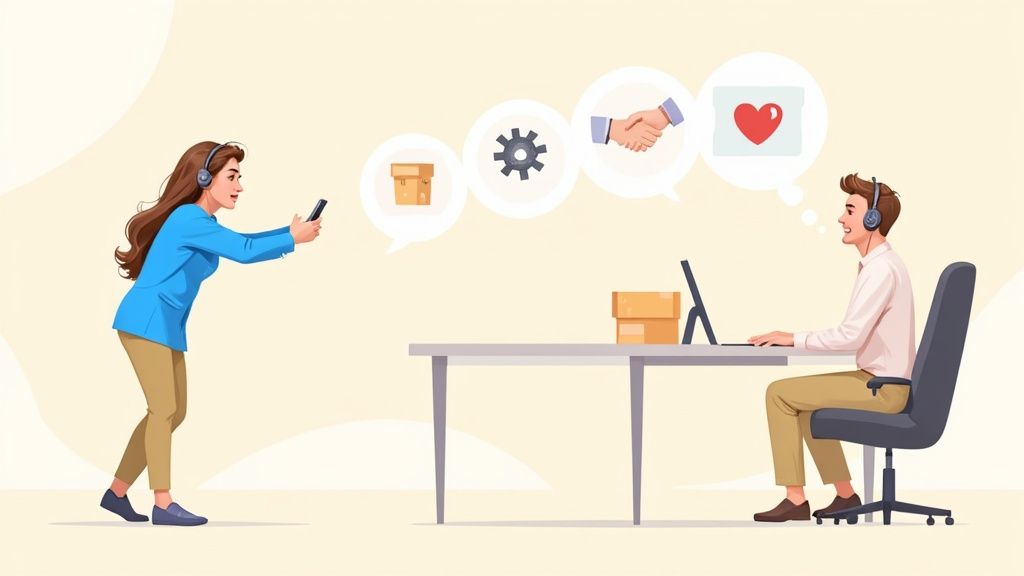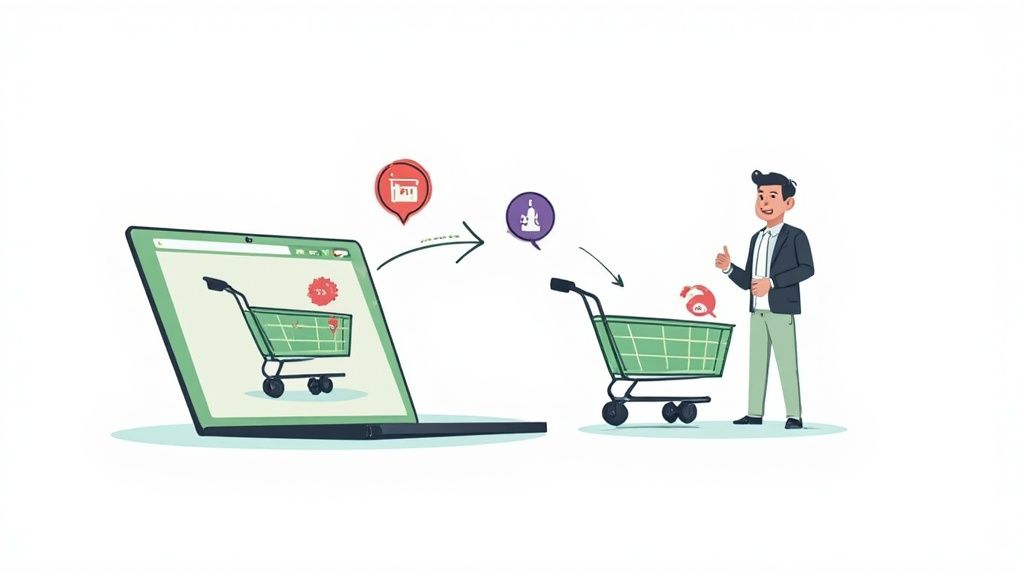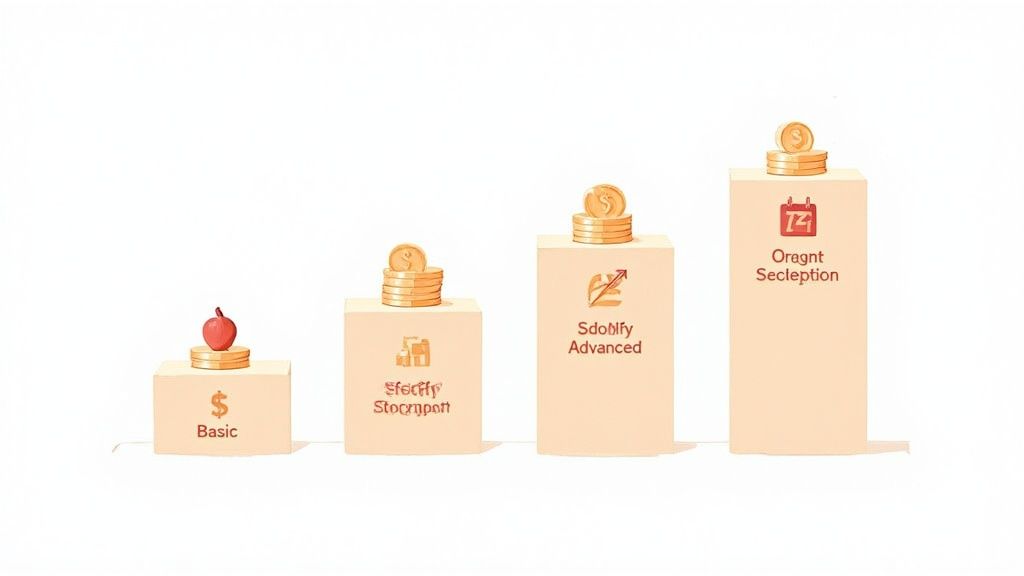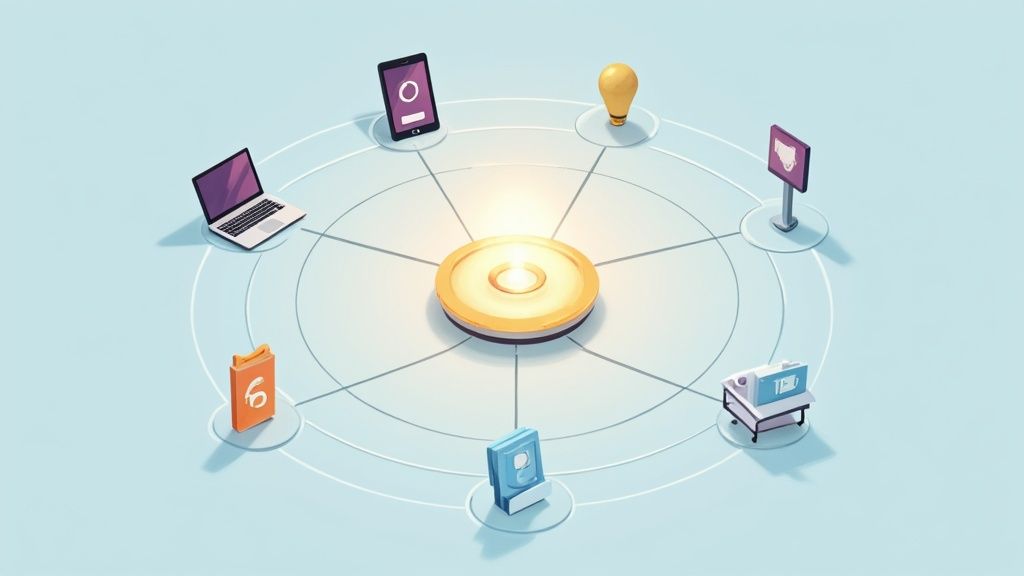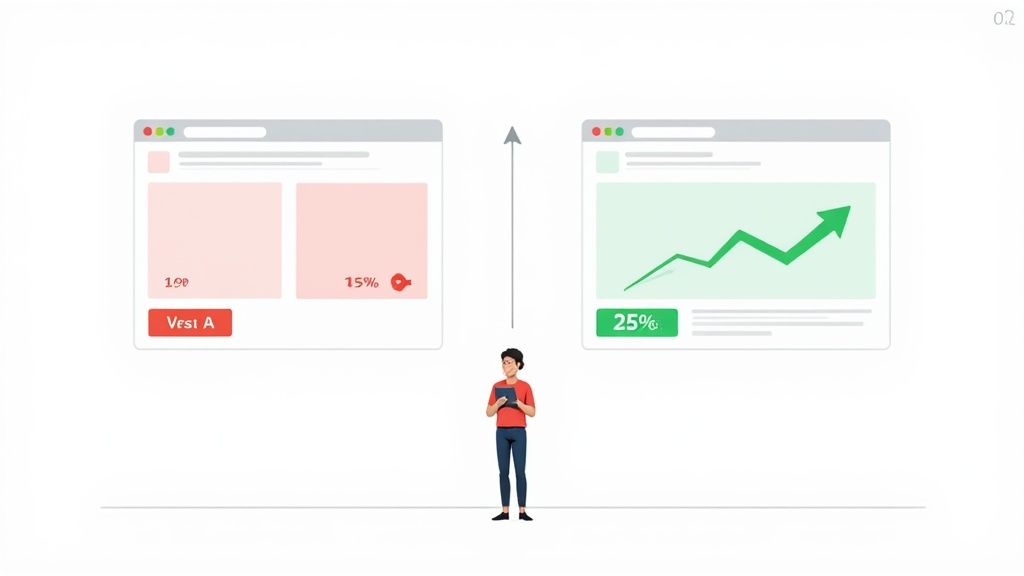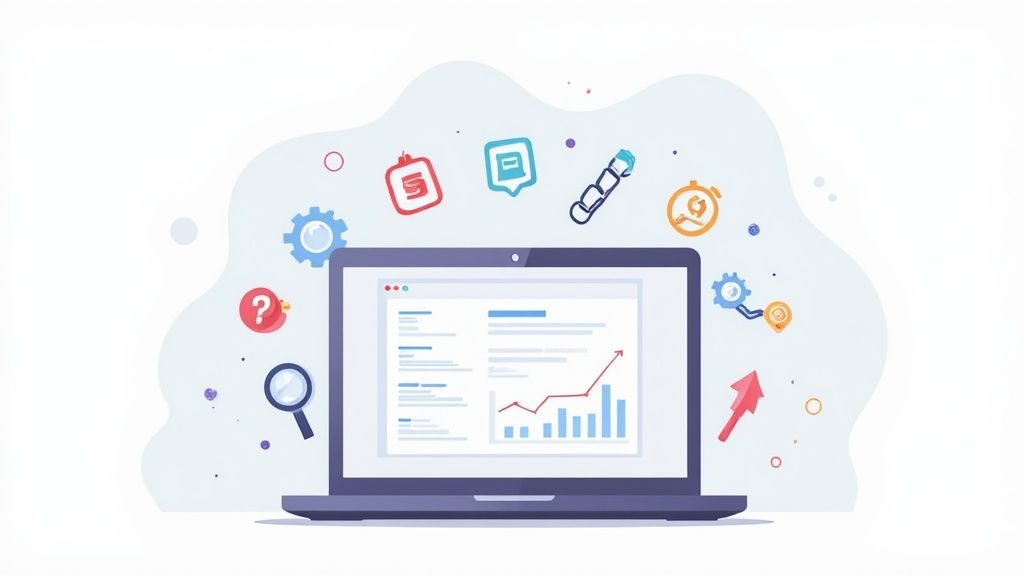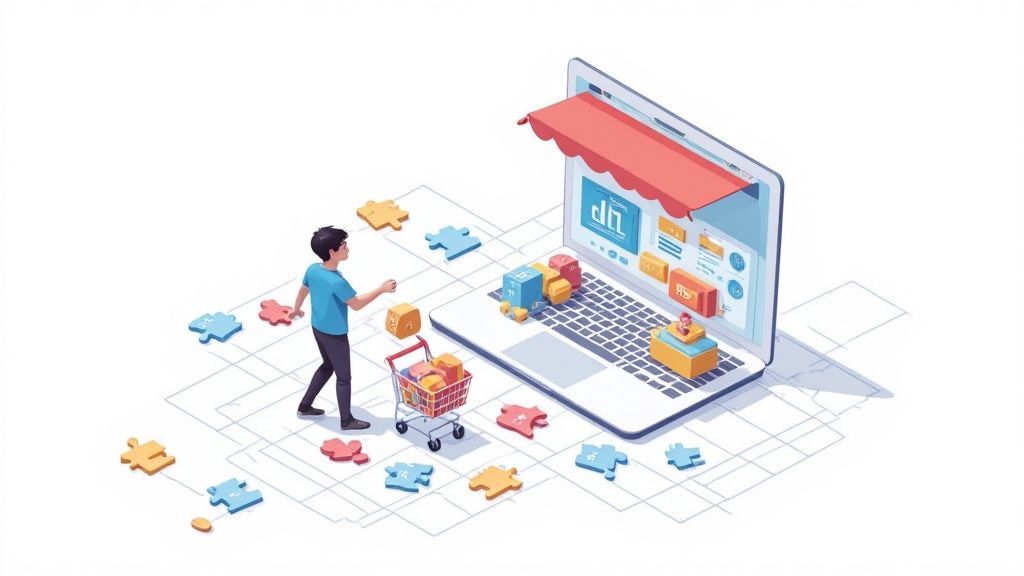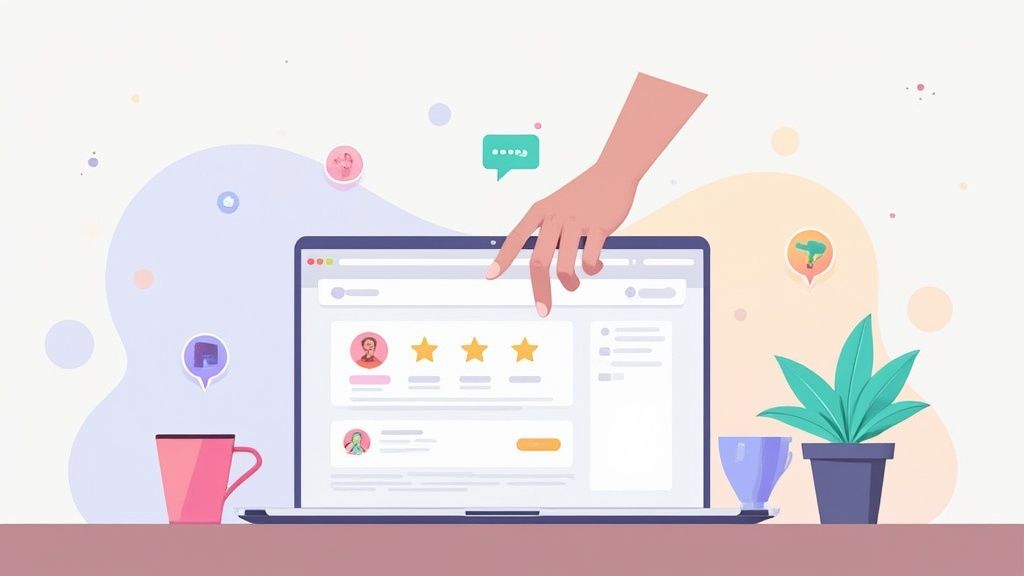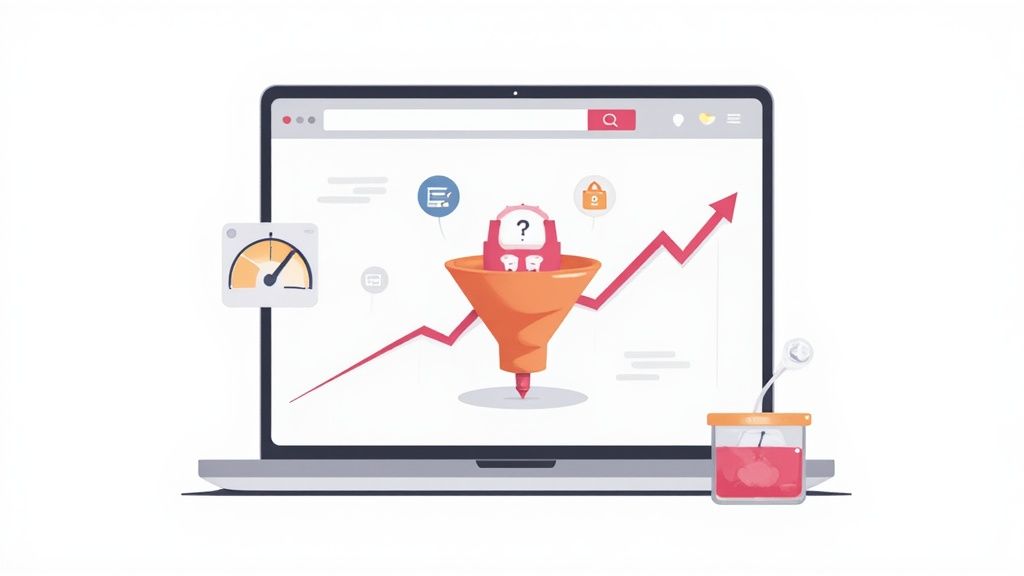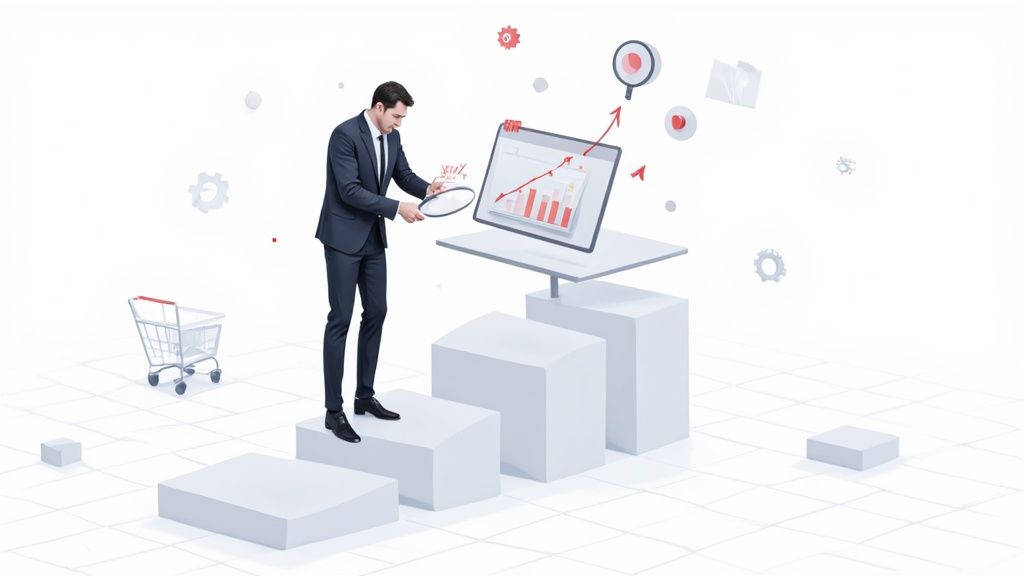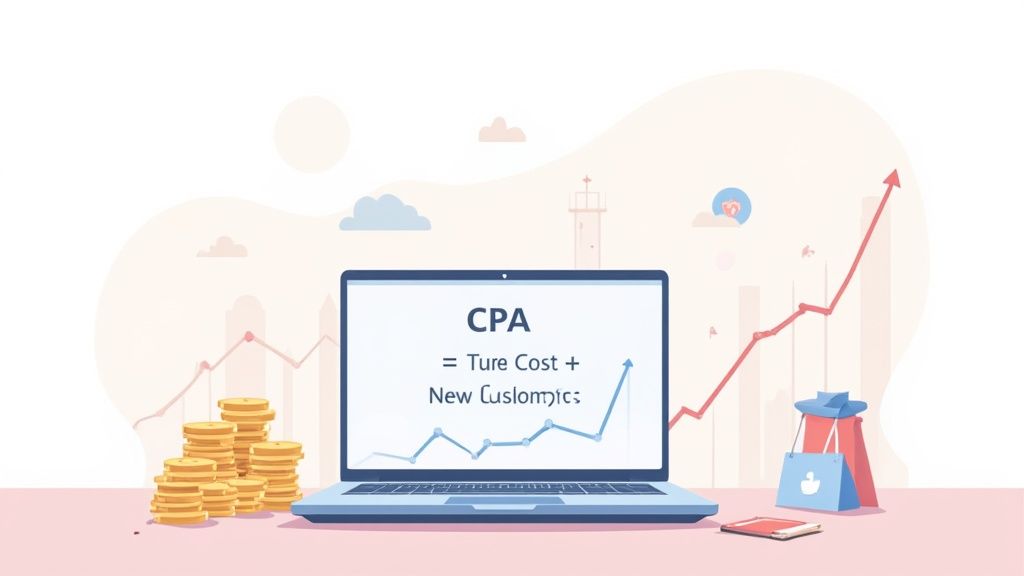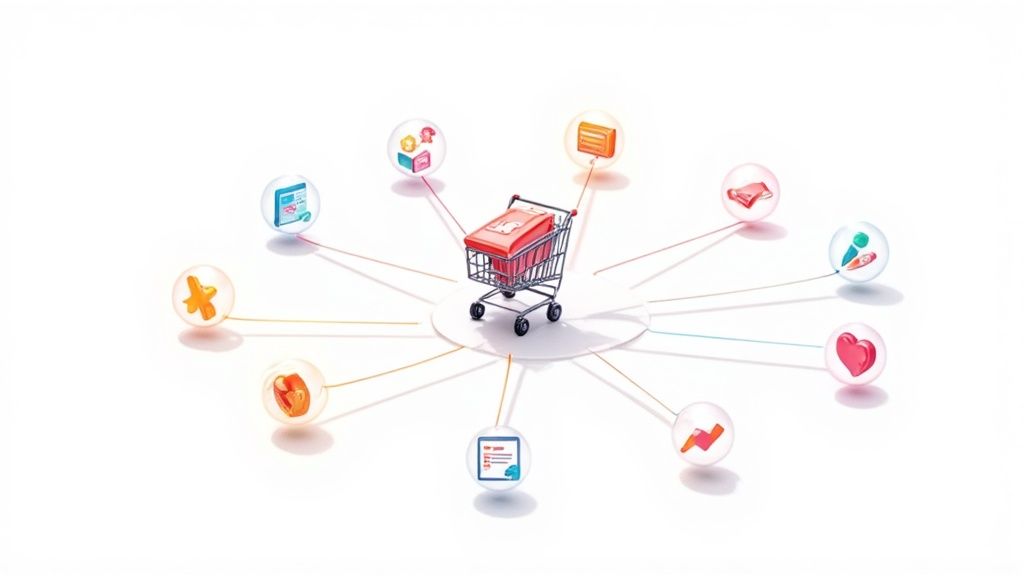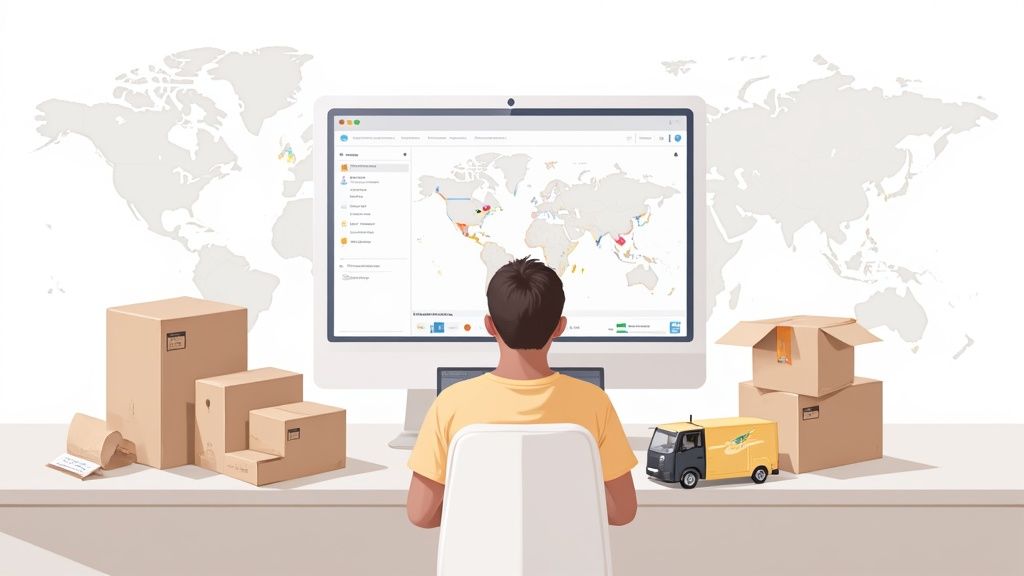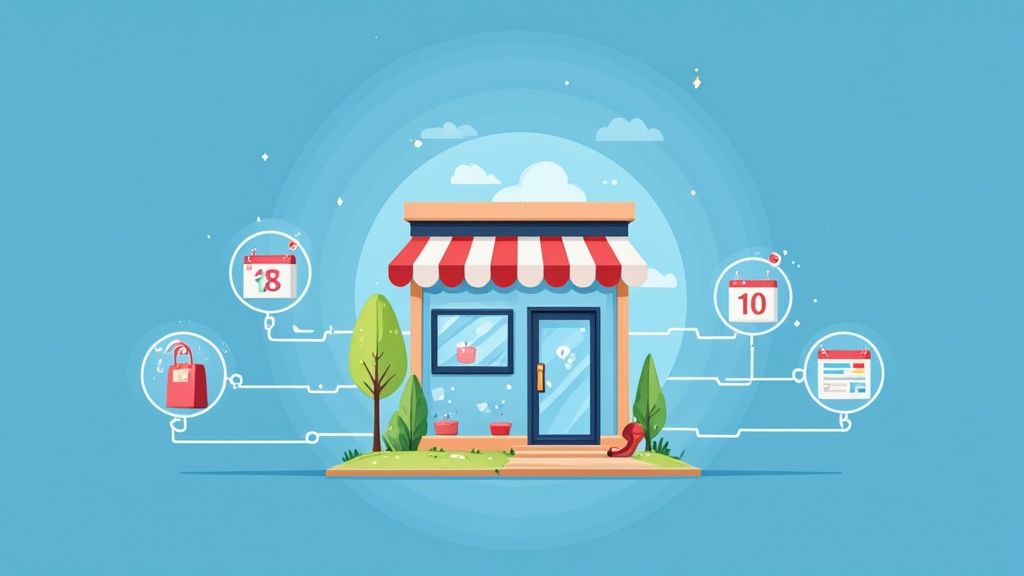
Link building for an e-commerce site is all about getting links from other websites pointing back to your online store. It's not just a numbers game; the goal is to earn high-quality, relevant links that essentially act as votes of confidence. These links signal to search engines like Google that your store and your product pages are trustworthy and valuable, which is a huge deal for getting seen in a crowded market.
Why Backlinks Are Your Ecommerce Store's Superpower
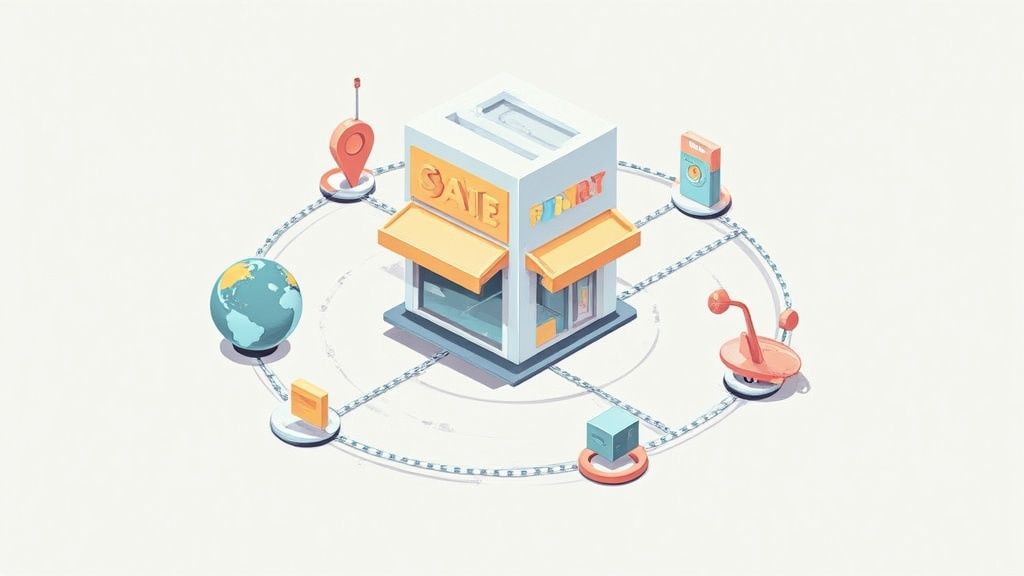
Many store owners get completely wrapped up in product sourcing, site design, and running paid ads. It's easy to do. But in the process, they often miss one of the most powerful levers for long-term growth: backlinks.
Good links are so much more than a simple SEO metric. They form the bedrock of your store’s authority and credibility, both for search engines and for actual customers.
Think of it this way: every backlink from a reputable website is a strong, public recommendation. When a popular industry blog or a trusted review site links to one of your products, they’re telling their audience—and Google—that you're a legitimate, valuable resource. That trust signal is one of the heaviest hitters when it comes to determining your search rankings.
The Direct Impact on Your Bottom Line
A solid link-building strategy does more than just help you climb the search results; it creates a powerful cycle of growth that directly impacts your business.
- Increased Organic Traffic: Ranking higher for your most important keywords means more potential customers find you without you having to pay for every single click. This is the kind of sustainable, long-term traffic you want.
- Targeted Referral Traffic: A link from a niche blog doesn't just pass on "link juice." It sends you visitors who are already warmed up and interested in what you sell, and that traffic often converts at a much higher rate.
- Enhanced Brand Authority: Seeing your brand pop up on trusted sites builds real credibility with consumers. That perception of authority makes it much easier for a new customer to trust you with their credit card.
A strong backlink profile is a competitive moat. It’s a durable asset that is incredibly difficult and time-consuming for your competitors to replicate, giving you a lasting advantage in the market.
Moving Beyond a Technical Chore
Ultimately, you have to stop thinking of link building as some tedious, technical task and start seeing it as a core marketing function. It’s a strategic investment in your store’s digital footprint and its long-term financial health.
To really get a handle on the power of backlinks, it helps to understand the bigger picture of What is Search Engine Optimization, since links are a foundational pillar of any successful campaign. Every high-quality link you earn strengthens your store's ability to attract customers, build trust, and drive sales for years to come.
Building a Link-Worthy Ecommerce Foundation
Let's get one thing straight: successful link building for an e-commerce site doesn't start with an outreach email. It starts with your own website.
Before you can even think about asking someone for a link, your online store has to be a place they’d actually want to link to. This means building a solid, credible, and genuinely valuable foundation that makes other sites want to reference you.
Without this groundwork, even the most creative outreach campaign will fall flat. The goal is to create what we call "linkable assets"—pages and resources so good that other sites link to them naturally. This flips the script from constantly begging for links to earning them.
Create Your Own Link Magnets
Linkable assets are the core of any sustainable link-building strategy. We're not talking about your standard product and category pages here. These are resources that offer unique value that bloggers, journalists, and industry experts are excited to share with their audience.
So, what unique value can you offer? This isn't just about selling; it's about solving real problems for your customers.
- In-Depth Buying Guides: Aim to create the single best resource on the internet for choosing a product in your niche. If you sell coffee makers, don't just list them. Write a 3,000-word guide covering every type, brewing method, and key feature, complete with comparison charts and pro tips.
- Interactive Tools: Build a simple calculator, quiz, or configurator that helps your visitors. A furniture store could create a "Room Layout Planner," or a skincare brand might offer a "Personalized Routine Finder." Tools like these are magnets for links because they provide direct, hands-on value.
- Original Research or Data: Survey your customers on their habits or analyze your sales data to find interesting trends. Imagine publishing a report titled, "We Analyzed 10,000 Sales: This is the Most Popular Sneaker Color in America." That's the kind of original data journalists and bloggers love to cite.
A huge part of creating these assets is mastering how to write compelling website copy that pulls visitors in and provides undeniable value.
The real goal here is to make your website an indispensable resource. When someone in your industry needs a definitive guide or a useful tool to link to, your site should be the first one that comes to mind.
Nail the Technical Essentials First
Even the most incredible content will struggle to earn links if your website is a technical mess. Both search engines and people value a fast, smooth, and secure experience. Before you even think about outreach, run a quick technical health check.
Your site absolutely must be:
- Fast: Page speed is a massive ranking factor. A site that takes more than three seconds to load is bleeding visitors. Use Google's PageSpeed Insights to find and fix what's slowing you down.
- Mobile-Friendly: The simple truth is that most of your traffic is probably coming from mobile devices. Your store needs to look and work flawlessly on a smartphone, with easy-to-tap buttons and readable text.
- Secure: An SSL certificate (HTTPS) is completely non-negotiable for e-commerce. It encrypts user data, builds trust with customers, and is a basic requirement for search engines.
Skipping these technical basics is like building a beautiful house on a shaky foundation. It's only a matter of time before things start to fall apart.
Analyze Your Competitors' Backlink Profiles
One of the smartest ways to kickstart your strategy is to see what's already working for your competition. By analyzing their backlink profiles, you get a clear roadmap of who is linking to them and why, uncovering a goldmine of potential opportunities.
Using SEO tools like Ahrefs or SEMrush, you can dig into their strategies. Look for patterns:
- Are they getting tons of links from product reviews on niche blogs?
- Have they been featured in gift guides on major publications?
- Do they have one killer resource that everyone in the industry seems to link to?
But don't just go out and try to copy their links one-for-one. Use this intel to find strategic gaps. If your competitor has a popular buying guide that's earned 50 backlinks, your mission is to create one that’s more detailed, better designed, and more current.
This "skyscraper" approach lets you build on their success by creating an asset that is so obviously better, it becomes the easy choice for anyone looking for the best resource to reference.
Using Digital PR to Earn High-Authority Links
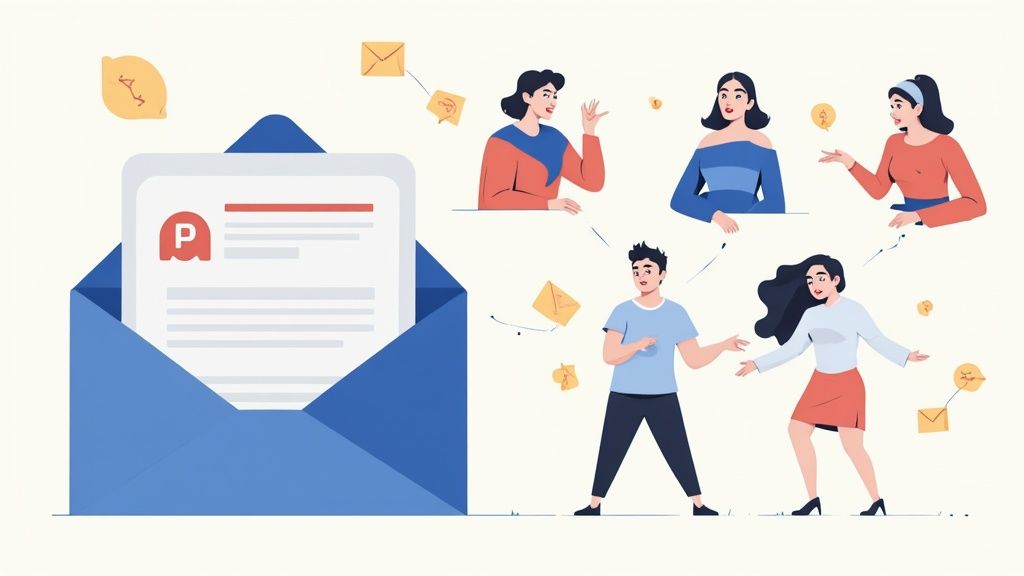
While tactics like broken link building are solid, Digital PR is how you land the truly game-changing backlinks. The ones that don’t just move the needle—they redefine your brand’s authority.
This isn’t about just asking for links. It’s about earning media coverage by becoming the source of a compelling story.
Digital PR involves creating newsworthy campaigns and pitching them to journalists, bloggers, and publications. When they cover your story, they naturally link back to your site, often from high-authority domains you could never land otherwise.
For an e-commerce store, this is the perfect play. You get a powerful link that boosts your SEO, combined with a huge wave of brand awareness and valuable referral traffic. It’s a win-win that pays off immediately and for years to come.
Finding Newsworthy Angles in Your Business
The key to great Digital PR is understanding that you don't need a massive budget to create a story. Your business is already a goldmine of unique data and insights that journalists crave. You just have to know where to look.
Put on your reporter hat and start digging into your own assets. You’ll be surprised at the compelling narratives hidden in your daily operations.
Here are a few places to start your search:
- Analyze Your Sales Data: Do you sell way more hiking boots in Colorado than any other state? Did sales for a specific product spike after a TikTok trend took off? This internal data is exclusive to you and can easily be turned into a story like, "New Data Reveals the Top 10 States for Outdoor Adventurers."
- Survey Your Customers: Ask your audience interesting questions related to your niche. A pet supply store could survey 1,000 customers about their dog's favorite toy, leading to a headline like, "Survey Shows Pups Overwhelmingly Prefer Squeaky Toys to Chew Ropes."
- Lean Into Your Brand Story: Does your brand have a unique origin story or a powerful mission? Maybe you use sustainable materials or donate a portion of profits to a specific charity. These are the kinds of narratives that resonate with journalists looking for human-interest pieces.
The most powerful Digital PR campaigns often come from simple, authentic stories backed by data. You don't need to invent something wild; you just need to frame the interesting things your business already knows in a way that’s compelling to an outside audience.
Crafting the Perfect Pitch
Once you've got a newsworthy angle, it's time to get it in front of the right people. This is where so many campaigns fall flat. A generic, mass email blasted to hundreds of journalists is a surefire way to get ignored.
Your outreach has to be targeted, personal, and brief.
- Identify the Right Journalists: Don't pitch the generic news desk. Find individual writers who have covered similar topics before. Use tools like HARO (Help a Reporter Out) or just search for articles in your niche and see who wrote them. A quick look at their author profile or Twitter bio will tell you what they're into.
- Write a Compelling Subject Line: Journalists get hundreds of emails a day. Your subject line is the pitch. Instead of "Story Idea," try something specific and data-driven like, "DATA: We Analyzed 20,000 Purchases to Find the Top Summer Fashion Trend."
- Keep Your Email Short and Sweet: Get straight to the point. Briefly introduce your story, highlight the single most interesting data point, and explain why their audience would care. End with a clear call to action, like offering them the exclusive or providing the full dataset.
The industry stats back this up. Digital PR has quickly become the most effective link building strategy for e-commerce sites. A recent survey shows that 48.6% of link builders now view digital PR as the top tactic, blowing past guest posting (16%).
With 73% of SEOs now using it, the shift is clear: relationship-based outreach is winning. You can dig into more link building trends and statistics in the full report.
Nurturing Media Relationships for Long-Term Success
Getting a single Digital PR hit is fantastic, but the real power comes from building lasting relationships with journalists. The goal isn't just one link; it's to become their go-to source for your industry.
After your story is published, always send a thank-you email. More importantly, share their article on your social channels and tag both the writer and the publication. Make them look good.
By being a reliable and helpful source, you position your brand as an expert. The next time that journalist needs a quote, data, or an expert opinion for a story, your name will be at the top of their list. This transforms a one-time tactic into a sustainable engine for high-authority placements.
Actionable Link Building Tactics for Online Stores
Theory is great, but real growth comes from putting that theory into practice. It's time to move from high-level strategy to the hands-on, proven tactics that consistently earn powerful links for ecommerce stores.
These aren't just one-off wins; they're repeatable plays you can run to start securing backlinks that actually move the needle. Think of them as sustainable processes for strengthening your store's authority over time.
This visual shows how something as simple as customer testimonials can be a springboard for new backlinks, boosting both your on-page conversions and off-page authority at the same time.

The big takeaway here is that assets you create for one purpose—like building trust with shoppers—can pull double duty for link building. That’s how you build a powerful, efficient marketing engine.
Master the Art of Broken Link Building
If you're looking for a direct and effective way to build links, broken link building is tough to beat. The concept is refreshingly simple: you find a dead link on a quality website, create a resource that's even better than what was originally there, and then reach out to the site owner suggesting your link as the replacement.
For an ecommerce store, this is a perfect tactic.
Imagine you find a "Best Camping Gear of 2024" roundup on a popular outdoor adventure blog. You click on a link to a competitor's tent and... 404 error. That page is gone.
This is your opening. You can shoot the blog owner a quick email, politely point out the dead link (which helps them improve their site's user experience), and offer up your own high-quality tent's product page as the perfect, working replacement. It’s a classic win-win.
Tap Into Your Supplier and Manufacturer Network
This is an absolute goldmine of relevant, high-authority links that so many stores completely overlook. Your suppliers and manufacturers often have "Where to Buy" or "Stockists" pages on their websites, and you simply need to make sure your store is on that list.
These links are incredibly valuable for a few key reasons:
- High Relevance: The link comes from a site directly related to the products you sell—a huge positive signal for Google.
- High Authority: Manufacturers typically have established websites with solid domain authority.
- High-Intent Traffic: Shoppers visiting a manufacturer's site are often ready to buy and are just looking for a reputable retailer.
Make a list of every single brand you carry. Go to their websites and hunt for those retailer pages. If you aren't listed, a quick, friendly email to your sales rep is usually all it takes to get added. This is low-hanging fruit you can’t afford to miss.
Turn Product Reviews into Powerful Backlinks
Partnering with bloggers and influencers in your niche is a classic for a reason—it works. But the real goal here isn't just a fleeting social media shoutout. It's about securing a permanent, valuable backlink within an authentic review on their blog.
Start by identifying bloggers who genuinely serve your target audience. Forget about vanity metrics like follower counts and focus on engagement and niche relevance. A micro-influencer with 5,000 die-hard fans of your product category is almost always more valuable than a general lifestyle blogger with 100,000 passive followers.
Don't just send out free products and cross your fingers. Build a real relationship. Offer their audience an exclusive discount or provide unique info about the product's design process to help them create a richer, more compelling review.
The best-case scenario is an in-depth, honest review packed with photos, personal experiences, and a clear, followable link back to your product page. This not only builds a fantastic backlink but also drives highly qualified referral traffic for months, sometimes even years.
Use Guest Posting to Build Topical Authority
Guest posting is far from dead; it has just grown up. The old-school method of blasting low-quality blogs with generic articles is completely useless now. Today, strategic guest posting is about placing high-value content on respected, niche-specific blogs to establish your brand as an authority.
The key is to contribute, not just self-promote. Don't even think about pitching an article that’s a thinly veiled ad for your products. Instead, offer genuine expertise.
- If you sell high-end kitchen knives, write an expert guide for a foodie blog on "How to Properly Sharpen and Maintain Your Chef's Knife."
- If you sell eco-friendly cleaning supplies, pitch a home decor blog an article on "A Complete Guide to Non-Toxic Spring Cleaning."
Within that genuinely helpful content, you can naturally place a contextual link back to a relevant category page or in-depth guide on your own store. This tactic positions you as an expert, builds a high-quality link, and introduces your brand to a brand-new, highly relevant audience.
For a deeper dive into more tactics, check out our complete guide on ecommerce link building strategies.
Comparing Common Ecommerce Link Building Tactics
To help you decide where to focus your efforts, it helps to see how these different tactics stack up against each other. Each one has its own level of difficulty and is better suited for certain types of pages on your site.
As you can see, the "easiest" win is often securing those supplier links, which are perfect for your homepage. For building authority to content and category pages, broken link building and guest posting offer the highest quality links, but they also require more sweat equity to execute well.
How to Measure and Budget for Your Link Building

Let's be real: a link building strategy without clear metrics is just wishful thinking. You can pour time and money into it, but if you're not tracking the right data, you're flying blind. You'll never truly know what's working, what's a waste of resources, or how to justify spending more.
This is what separates a hopeful tactic from a profitable marketing channel. We're not just counting backlinks here. We're talking about connecting your efforts to tangible business outcomes—more traffic, higher rankings for your "money" keywords, and, most importantly, more sales.
Identifying the KPIs That Actually Matter
Forget the vanity metrics. A sudden spike in your backlink count might look good on paper, but it means nothing if those links are from junky sites that don't move the needle. To get a real sense of your campaign's impact, you need to zero in on a few key performance indicators (KPIs).
These are the core metrics that will give you an honest picture of your progress:
- New Referring Domains: This is a big one. Gaining 10 links from 10 different relevant websites is worlds more valuable than getting 10 links from the same site. Keep an eye on the number of unique, quality domains linking to you each month.
- Organic Keyword Rankings: Start tracking the search engine positions for the product and category pages you're targeting. When these start climbing, it’s a direct signal that your link building is boosting your authority in Google's eyes.
- Referral Traffic Growth: Jump into Google Analytics and see how many people are landing on your store directly from the links you've built. This is the most immediate traffic win you'll see from your outreach.
Connecting Links to Your Bottom Line
While those SEO-focused KPIs are great for tracking progress, the end game is always return on investment. You have to tie your link building activities back to actual revenue and customer acquisition.
This is where the rubber meets the road. Focus on these two business-level metrics:
- Sales from Referral Traffic: Don't just stop at tracking visitors. Get your ecommerce tracking set up in Google Analytics to see how many of those referral visitors actually complete a purchase. This tells you which links are sending you high-intent customers who are ready to buy.
- Cost Per Acquisition (CPA): This is the ultimate benchmark. By tracking your total link building spend against the number of new customers you acquire, you can calculate your CPA. Knowing this number is critical for budgeting and figuring out how to scale your efforts profitably. If you need a refresher, you can learn more about how to calculate your cost per acquisition and see how it fits into your bigger marketing picture.
A successful link building campaign doesn't just improve rankings; it delivers profitable customers. If the lifetime value of the customers you acquire is greater than your cost to acquire them, you've built a sustainable growth engine.
Setting a Realistic Link Building Budget
One of the first questions I always get is, "How much should I spend?" The honest answer? It depends entirely on your goals, your industry, and how fierce the competition is. You have to think of link building as a strategic marketing expense, not just another line-item cost.
To stay in the game, you need to be prepared to invest. Recent industry data from FatJoe shows a clear trend: serious brands are allocating real money to quality link acquisition. For instance, their survey revealed that 47% of link builders spend more than £600 per month, with a hefty 14% investing over £1,500 monthly. This isn't pocket change; it's a sign that brands view link building as a crucial part of their marketing mix. You can dig into more of the data on link building financial trends from FatJoe.
What's more, over 61% of those surveyed expected their budgets to increase. The writing is on the wall: prioritizing high-quality backlinks for ecommerce SEO is becoming the new standard.
As you map out your own budget, weigh these factors:
- Your Goals: Are you aiming for slow and steady growth, or are you trying to aggressively capture market share? Faster results demand a bigger investment.
- Competitor Activity: Use SEO tools to get a ballpark idea of what your top competitors are doing. If they have a massive head start, you'll likely need to invest more to close the gap.
- In-House vs. Agency: Are you building an in-house team or hiring an agency? For an in-house approach, you need to factor in salaries and tool subscriptions. For an agency, you'll be looking at package costs.
Ultimately, your budget is an investment in a durable competitive asset. The authority and traffic you build today will keep paying dividends for years to come, long after you've made the initial investment.
Common Ecommerce Link Building Questions
When you're diving into link building for your store, a lot of questions pop up. It's totally normal. Getting straight answers is the first step to building a strategy that actually works without feeling overwhelming. Let's get into some of the most common things store owners ask.
How Many Backlinks Do I Need?
This is the big one, isn't it? But honestly, there's no magic number.
Instead of chasing a specific quantity, you need to shift your focus to quality and relevance. Seriously, ten powerful links from respected blogs in your niche will move the needle way more than 100 random, low-quality links from directories nobody's heard of.
A much better way to think about it is to see what your top competitors are doing. Use an SEO tool to check out how many different websites (referring domains) are linking to their most important category and product pages. This gives you a real-world benchmark to aim for, not just a number plucked out of thin air. The goal is to build a stronger, more authoritative link profile than theirs over time.
How Long Does It Take to See Results?
Link building is a classic marathon, not a sprint. It’s nothing like running paid ads where you see traffic the moment you switch them on. The impact from backlinks builds up slowly and steadily.
Generally speaking, you can start to see some positive movement in your keyword rankings within three to six months of consistent, high-quality link building.
But the full effect? That can take much longer. Google needs time to crawl pages, find your new links, and figure out how much authority to pass along. Patience is absolutely crucial here. The authority you're building is a long-term asset that keeps paying off for years, unlike an ad campaign that vanishes the second you stop funding it.
Think of link building like planting a tree. You won't get shade overnight, but the consistent effort you put in early on will grow into a strong, durable asset that provides lasting value.
Can I Build Links Directly to Product Pages?
You can, but it’s tricky and needs the right touch. Most websites are pretty hesitant to link directly to a page where you're asking for money, unless there's a really good reason for them to do so. Just emailing someone to say "my product is great, link to it!" almost never works.
Here are a few times when it does make sense:
- Product Reviews: A blogger or an online magazine is actually reviewing your specific product.
- Gift Guides: Your item gets featured in a roundup like a "Best Gifts for Coffee Lovers" list.
- Broken Link Building: You find a dead link on a site that used to point to a similar (but now discontinued) product, and you suggest yours as the perfect replacement.
For most of your outreach, you’ll find it’s much easier—and more effective—to build links to your killer content. Think in-depth buying guides or helpful blog posts. Then, from that content, you can add internal links pointing to your relevant product pages. This tactic builds the authority of your whole site, which lifts up all your pages, including the ones that make you money.
Ready to stop guessing and start growing? At ECORN, our team of Shopify specialists can build a link building strategy that drives authority, traffic, and sales. Let's build your competitive edge together.






